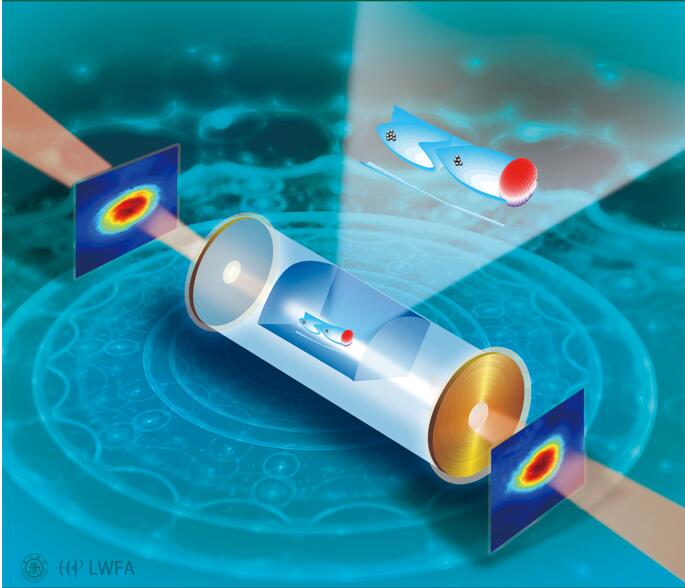SPECIAL TOPIC-Terahertz spintronic optoelectronics
SPECIAL TOPIC—Terahertz spintronic optoelectronics
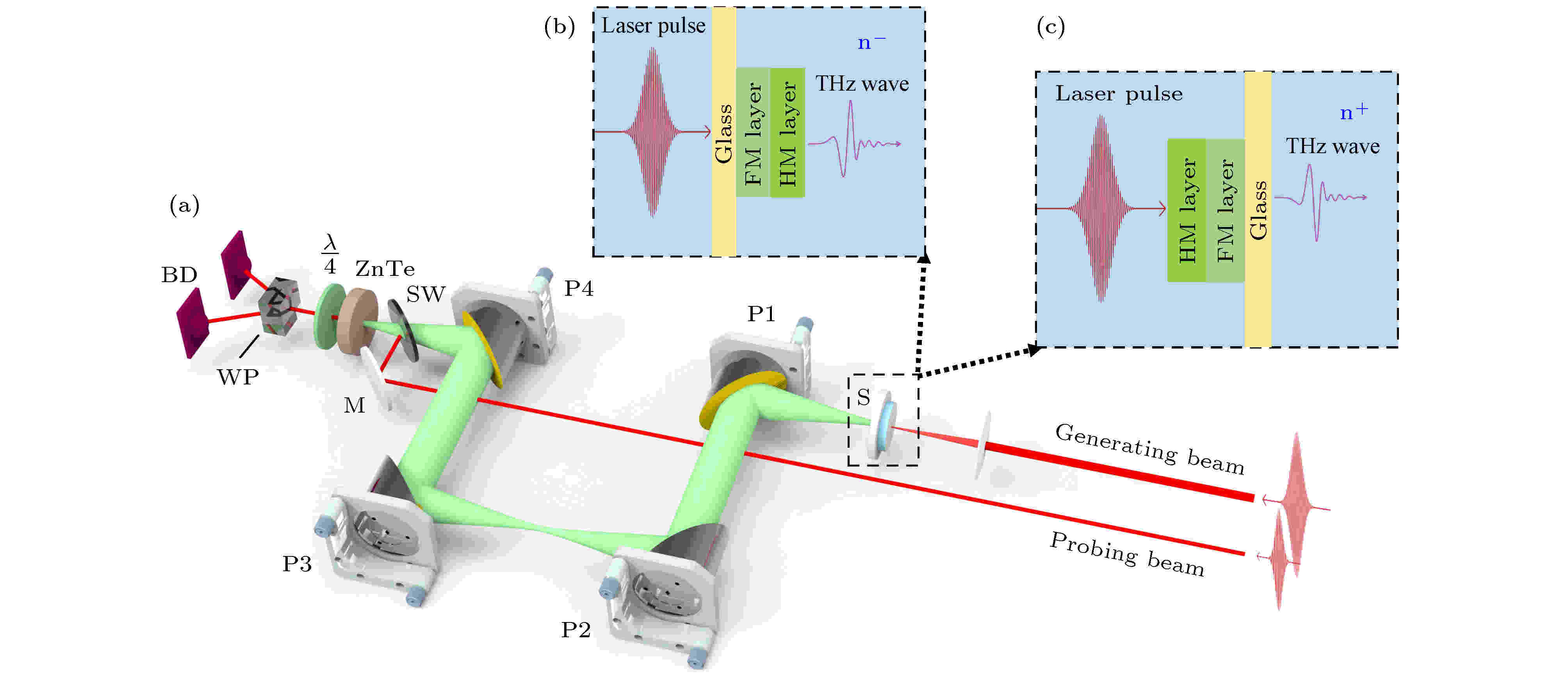
2020, 69 (20): 200702.
doi: 10.7498/aps.69.20200526
Abstract +
We systematically investigate the influence of annealing effect on terahertz (THz) generation from CoFeB/heavy metal heterostructures driven by femtosecond laser pulses. The THz yield is achieved to increase triply in W/CoFeB through annealing effect, and doubly in Pt/CoFeB. The annealing effect originates from both the decrease of synthetic effect of THz absorption and the increase of hot electron mean free path induced by crystallization, with the latter being dominant, which is experimentally corroborated by THz transmission measurement of time-domain spectrum and four-probe resistivity t. Our observations not only deepen understand the spintronic THz radiation mechanism but also provide a novel platform for high speed spintronic opto-electronic devices.
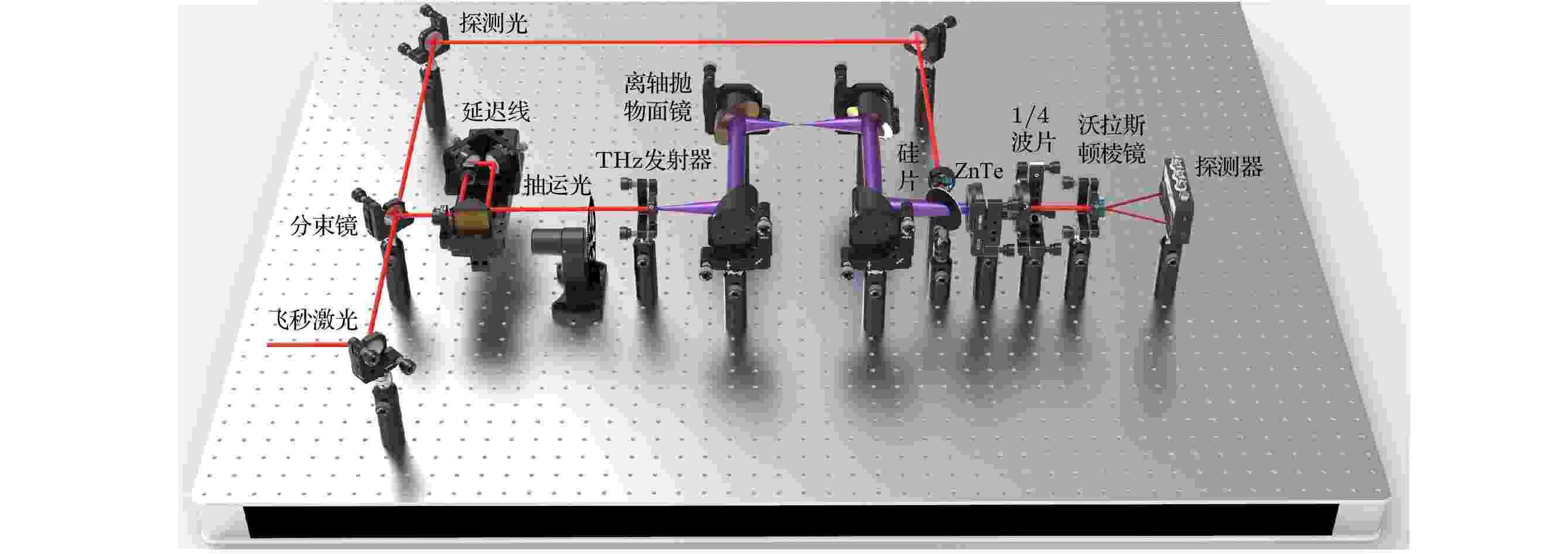
2020, 69 (20): 200703.
doi: 10.7498/aps.69.20200623
Abstract +
The terahertz frequency band is located between infrared and microwave in the electromagnetic spectrum. The interesting properties such as broadband, low energy, high permeability, fingerprint, etc. make terahertz wave important for applications in the fields of aerospace, wireless communications, security, materials science, biomedicine, etc. The development and application of terahertz science and technology are largely limited by the terahertz sources, therefore it is crucial to develop new terahertz radiation sources. Recently, it was shown that terahertz spintronic not only provides the possibility of physically controlling the femtosecond spin current, but also expects to be the next-generation ultra-wideband, low-cost, high-efficiency terahertz sources. In this paper we systematically review the historical development, experimental devices, emission mechanisms, material selections, and future prospects of the spintronic terahertz sources. We present the research advances in the physical mechanisms of ultrafast spin current induced by femtosecond laser, the spin charge conversion at ferromagnetic and non-magnetic interfaces, and the terahertz emission triggered by ultrafast pulses. This review also introduces spintronic terahertz sources based on heavy metals, topological insulators, Rashba interfaces, and semiconductor systems.
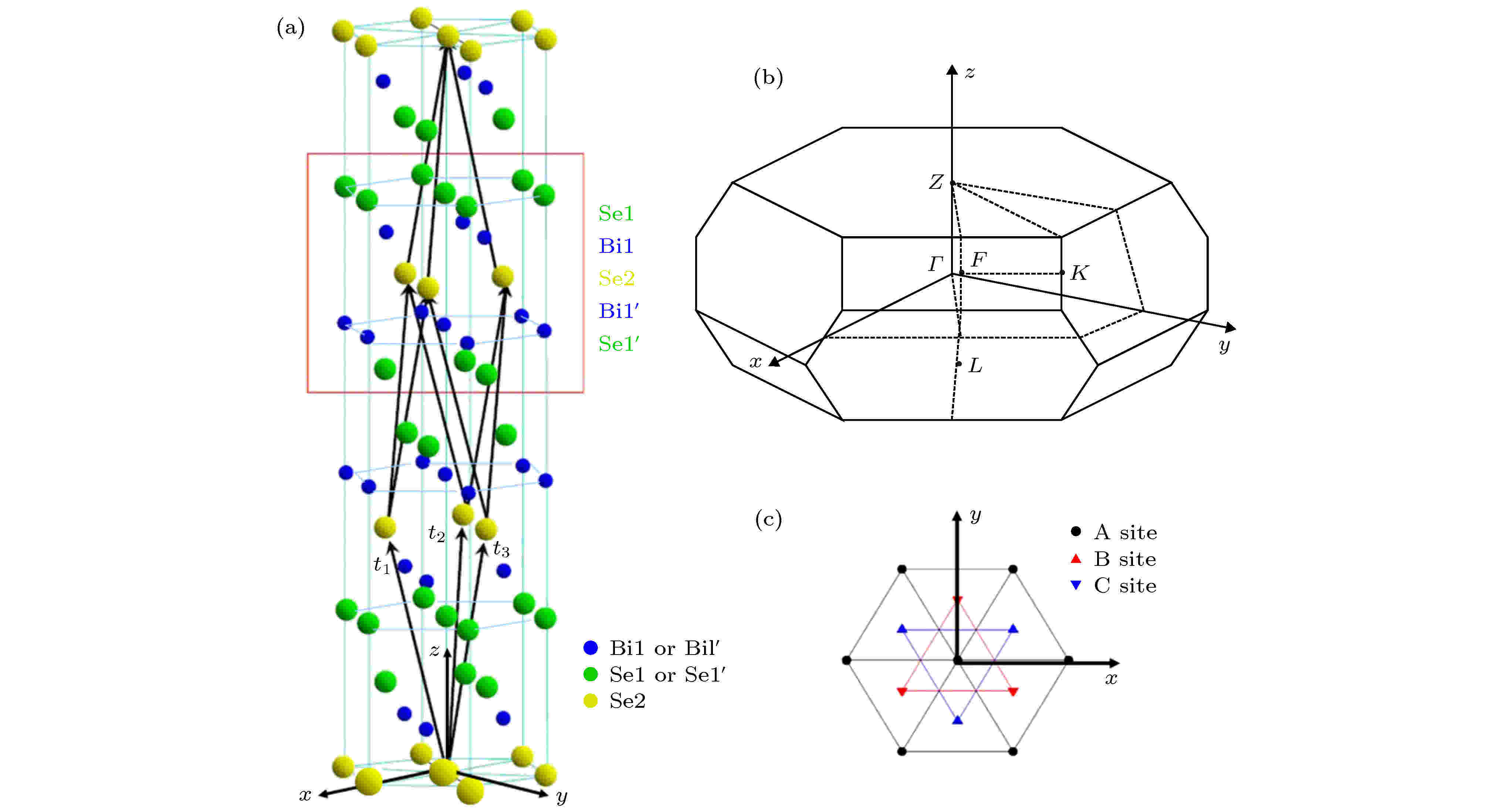
2020, 69 (20): 200704.
doi: 10.7498/aps.69.20200680
Abstract +
Ferromagnet/nonmagnet (FM/NM) heterostructure under the excitation of femtosecond laser has proved to be a potential candidate for high-efficiency terahertz (THz) emission. Topological insulator (TI) is a novel two-dimensional (2D) material with a strong spin-orbital coupling, which endows this material with an extremely large spin-Hall angle. Thus, TI appears to be an attractive alternative to achieving higher-performance spintronic THz emitter when integrated with ferromagnetic material. In this paper, we discuss the ultrafast photocurrent response mechanism in TI film on the basis of the analysis of its crystal and band structures. The discussion of the mechanism reveals a relationship between THz radiation and external conditions, such as crystal orientation, polarized direction and chirality of the laser. Furthermore, we review the spintronic THz emission and manipulation in FM/NM heterostructure. The disclosed relationship between THz radiation and magnetization directions enables an effective control of the THz polarization by optimizing the system, such as by applying twisted magnetic field or fabricating cascade emitters. After integration, the FM/TI heterostructure presents a high efficiency and easy operation in THz radiation. This high-performance topological spintronic THz emitter presents a potential for the achievement of arbitrary polarization-shaping terahertz radiation.

2020, 69 (20): 204202.
doi: 10.7498/aps.69.20200715
Abstract +
Terahertz technology shows great potential applications in imaging, sensing and security. As is well known, the conventional solid-state broadband terahertz sources rely primarily on the nonlinear optical crystals and photoconductive antennas. Therefore, one major challenge for the next generation of terahertz technology is to develop the high-efficient, ultra-broadband and low-cost terahertz sources. In recent years, much attention has been paid to the spintronic terahertz emitters made of the metallic magnetic heterostructures on a nanometer scale. In this paper, the underlying physical mechanisms associated with this type of terahertz emitter is discussed. They mainly include the ultrafast demagnetization and the spin-charge interconversion processes. In order to further improve the terahertz emission efficiency, three main aspects are considered: appropriate choice of the materials (including conditions of the sample growing), film thickness, and new structure design. In the end, a short conclusion and future perspective for this research direction are given briefly.

2020, 69 (20): 204205.
doi: 10.7498/aps.69.20201188
Abstract +
As a typical phase transition material, vanadium dioxide has attracted much attention in the study of metal-insulator transition behavior since its phase transition temperature is close to room temperature. The experimental results of various modulation provide important clues to studying the vanadium dioxide phase transition mechanism. These experiments not only deepen the understanding of the strong correlation between electrons with different spins in various transition metal oxides, but also make an opportunity for exploring their potential practical applications. Although the phase transition mechanism of vanadium dioxide is still controversial, one has already made tremendous efforts to understand the mechanism of metal-insulation phase transition in the past few decades, which is stimulated from various experiments on vanadium dioxide modulation. Here in this work, the single crystal and polycrystalline vanadium dioxide are investigated. Their modulation mechanisms are studied by using the continuous laser pumping-terahertz probe technique, and it is found that the absorption behaviors of terahertz pulses at the same pump fluence are obviously different. After systematically discussing the representative phase transition mechanism, it is found that the phase transition of single crystal vanadium dioxide is attributed to the Mott-type phase transition dominated by the electronic structure, and that the polycrystalline vanadium dioxide originates from the Peierls-type phase transition occurring during the lattice distortion. In the past, most of the optical modulation was implemented under the condition of femtosecond laser pumping. The new optical modulation method given in this work, is a supplement to previous all-optical modulation experiment and more likely to be conducive to a more in-depth understanding of the modulation mechanism of vanadium dioxides.

2020, 69 (20): 204206.
doi: 10.7498/aps.69.20201545
Abstract +
In polar materials, the transition of electrons in momentum space will change the spontaneous polarization. When excited by femtosecond pulse laser, the transient modulation of the electric polarization will radiate electromagnetic wave at terahertz frequency. In a magnetic ordered system, the coherent excited spin wave radiates electromagnetic waves of the same frequency in the process of precession and relaxation. The investigation of the terahertz emission spectra of these materials not only helps us to understand the ferroelectric and magnetic ordered dynamic processes of materials, but also provides a reference for searching for new terahertz sources. We study the terahertz emission spectrum of the polar antiferromagnet Fe2Mo3O8. Under the pumping of 800 nm laser, electrons in the material are excited across the band gap leading the electric polarization to be ultra-fast modulated. The broadband terahertz excitation spectrum from 0.1 to 3.5 THz is observed, and the direction of the terahertz electric field is along the inherent electric polarization direction of the material. After entering into the magnetic order state, two new single-frequency terahertz oscillations are observed, located at 1.25 THz and 2.7 THz respectively, which correspond to the excitation of the two antiferromagnetic spin waves of Fe2Mo3O8.

EDITOR'S SUGGESTION
2020, 69 (20): 207302.
doi: 10.7498/aps.69.20200682
Abstract +
Quasi-two-dimensional van der Waals ferromagnetic semiconductor CrSiTe3 with wide potential applications in optoelectronics and nanospintronics has aroused the immense interest of researchers due to the coexistence of intrinsic magnetism and semiconductivity. By combining untrafast femtosecond laser and terahertz spectroscopy, including terahertz time-domain spectroscopy, optical pump-terahertz probe spectroscopy and terahertz emission spectroscopy, we carry out systematic investigation into the van der Waals ferromagnetic semiconductor CrSiTe3 crystal. The experimental results indicate that the conductivity of the sample is robust against the temperature change and isotropic terahertz transmission in the ab-plane. Moreover, it is also observed that the photocarriers induced by 800 nm optical pump exhibit a relaxation in the biexponential form and the complex photoconductivity can be well reproduced by the Drude-Smith model. The main relaxation channel of photocarriers is the recombination of electron-hole pairs. With femtosecond pulse illuminating the surface of sample, a strong terahertz radiation signal with a broad band of 0–2 THz is observed. The present study provides the responses of CrSiTe3 to optical and terahertz frequency and offers crucial information for the future design of CrSiTe3-based electronic and optoelectronic devices.

COVER ARTICLE
2020, 69 (20): 207501.
doi: 10.7498/aps.69.20201507
Abstract +
As a typical helimagnet, ZnCr2Se4 possesses fascinating effects including magnetoelectric coupling, magnetostriction, negative thermal expansion, as well as possible diversity in quantum ground states. Here in this work, we investigate magnetic excitation arising from spiral spin structure in ZnCr2Se4 single crystal by using terahertz (THz) time domain spectroscopy (THz-TDS) under magnetic fields up to 10 T and at low temperatures. The magnetic resonance absorption is observed in a sub-THz region as the applied magnetic field is above 4 T, featuring the blue shift with magnetic field increasing. As the THz wave vector ( k ) is vertical to the external magnetic field (H), the single resonance frequency conforms well with the linear Larmor relation, corresponding to a spin structure transformation from helical to ferromagnetic state with magnetic field increasing in ZnCr2Se4. However, in the geometry in which both k and H are along the $ \langle 111\rangle $ direction of crystal, a well-defined resonance splitting emerges when H > 7 T. Especially, the high-frequency absorption shows pronouncedly nonlinear magnetic field dependence. It is suggested that such anisotropic spin dynamics below Néel temperature be linked with the field-driven quantum criticality unveiled in recent work.

2020, 69 (20): 207801.
doi: 10.7498/aps.69.20200031
Abstract +
Ultrafast spectroscopy is a powerful method to generate and control topological phase transitions and spin-polarized electrical currents in topological quantum materials. These light-induced novel physical properties originate from the topologically nontrivial states of Dirac and Weyl fermions. The topological semimetal molybdenum phosphide (MoP) exhibits double and triple degenerate points in the momentum space. We present the preliminary results of spin-polarized electrical currents and optical response investigations of MoP. We design and construct an experimental setup to perform the photocurrent generation and control by circularly polarized light in topological insulator Bi2Se3. The results compare well with those reported, which confirms the validity and reliability of our experimental setup. Further, we conduct the photocurrent experiment on MoP by using 400 nm laser pulses for excitation and successfully detect the current signals at different sample positions. We attribute the observed currents to photo-induced thermal currents (not the photo current associated with the triple degenerate topological properties), which facilitates generating and controlling photocurrents in MoP in the future investigation. Our thermal current investigations are of essence for further exploring the photocurrents in various types of topological quantum materials.

2020, 69 (20): 207802.
doi: 10.7498/aps.69.20201518
Abstract +
In this paper, the effects of magnetic field and nonmagnetic Y3+ doping on spin state and spin reorientation in HoFeO3 single crystal are systematically studied by the self-developed terahertz time-domain spectroscopy (THz-TDS) under magnetic field. By doping nonmagnetic Y3+, we find that the spin reorientation temperature range decreases. Meanwhile, we also find the type of spin reorientation of HoFeO3 does not change with Y3+ doping, indicating that the Y3+ doping can exchange the interaction energy of Ho3+-Fe3+ without introducing any new magnetic structure. Moreover, the resonance frequency of quasi-ferromagnetic mode (q-FM) decreases with temperature increasing in the low temperature range, while the resonance frequency of quasi-antiferromagnetic mode (q-AFM) increases with temperature increasing in the high temperature range in Ho1–xYxFeO3 single crystals. With the external magnetic field ( H DC) applied along the (110) axis, on the one hand the magnetic field can not only tune the resonant frequency of q-FM but also induce the spin reorientation in Ho1–xYxFeO3 single crystals, and on the other hand this magnetic field induced spin reorientation phenomenon can happen more easily if the temperature approaches to the intrinsic spin reorientation temperature range of the single crystals. Besides, the critical magnetic field induced spin reorientation increases with the doping of Y3+ increasing. Our research shows that THz spectroscopy data can be used to detect the doping concentration of Y3+ ions in HoFeO3; in addition, Y3+ doping can make the spin state in HoFeO3 crystal more stable and not easily affected by external magnetic fields. We anticipate that the role of doping and magnetic field in spin reorientation transition will trigger great interest in understanding the mechanism of the spin exchange interaction and the mechanism of external field tuning effect in the vast family of rare earth orthoferrites.
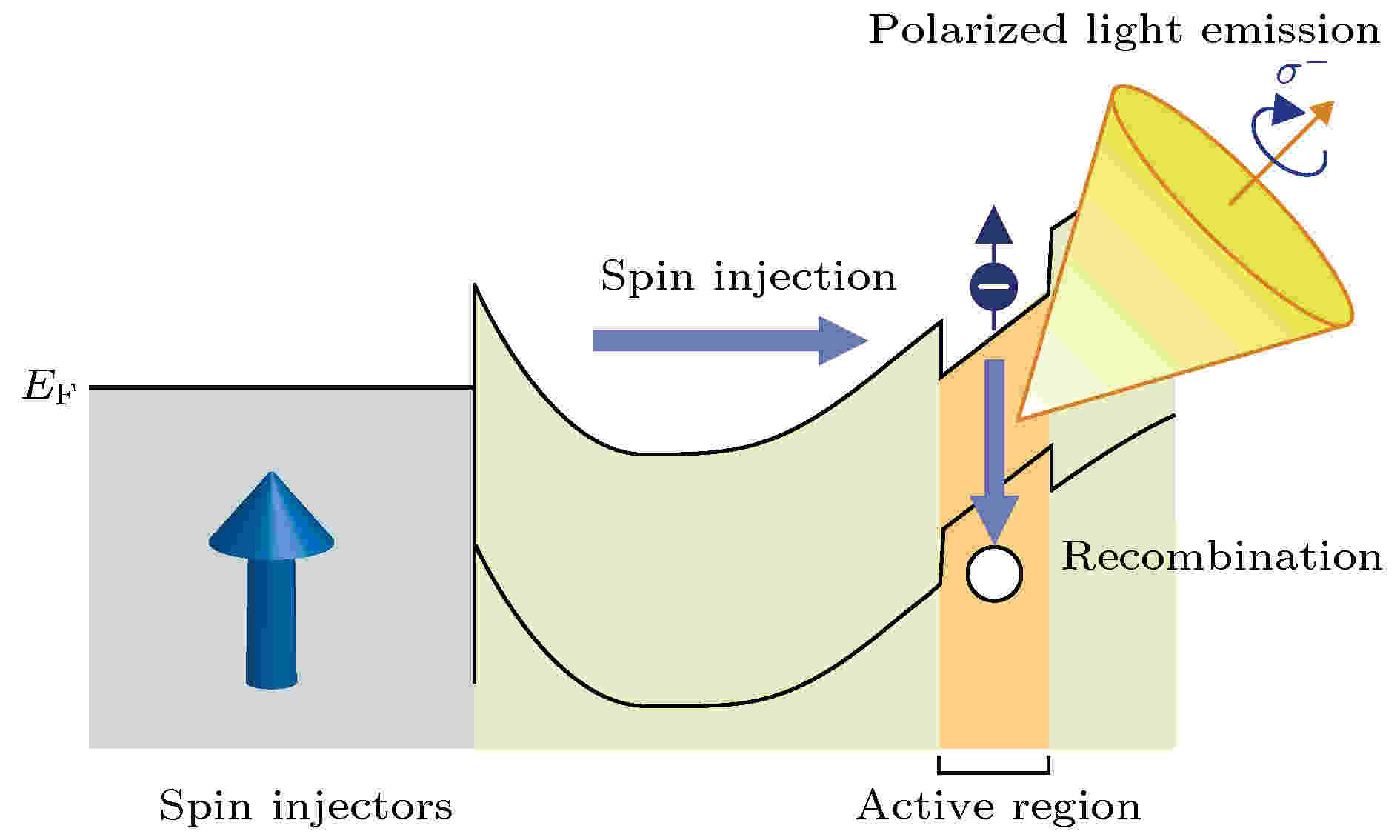
2020, 69 (20): 208501.
doi: 10.7498/aps.69.20200866
Abstract +
After more than 20 years of development, semiconductor spintronics has become an important and interdisciplinary research filed of spin-based physics, materials and phenomenon. Spin light emitting diode (spin LED) is one of the fascinating topics in semiconductor spintronic, and it is also one of devices in which the radiative recombination of spin-polarized carriers results in luminescence exhibiting a net circular polarization. The research of spin LED involves the studies of materials, structures, and spin based physics in spin injector and active region. The spin injection, spin transport, and spin detection are key factors for understanding the spin based physics in spin LED. Here in this paper, we comprehensively review the current research status and the latest results. Finally, we also discuss the future research trend.

2020, 69 (20): 208704.
doi: 10.7498/aps.69.20200733
Abstract +
Recently, ferromagnetic/non-magnetic heterostructures have been widely studied for the generation of terahertz (THz) emitter based on spin-to-charge conversion. Actually, thermal spintronics effectively combines thermal transport with magnetism for creating and detecting non-equilibrium spin transport. A spin current or voltage can be induced by a temperature bias applied to a ferromagnetic material, which is called spin Seebeck effect (SSE). In this paper, we present a SSE based THz emission by using the heterostructures made of insulating ferrimagnet yttrium iron garnet (Y3Fe5O12, YIG) and platinum (Pt) with large spin orbit coupling. Upon exciting the Pt layer with a femtosecond laser pulse, a spin Seebeck current arises, applying a temperature gradient to the interface. Based on the inverse spin Hall effect, the spin Seebeck current is converted into a transient charge current and then yields the THz transients, which are detected by electrooptic sampling through using a ZnTe crystal at room temperature. The polarity of the THz pulses is flipped by 180° when the direction of the external magnetic field is reversed. By changing the direction of the pump beam excitation geometry to vary the sign of the temperature gradient at the YIG/Pt interface, the polarity of the THz signal is reversed. Fast Fourier transformation of the THz signals yields the amplitude spectra centered near 0.6 THz with a bandwidth in a range of 0.1–2.5 THz. We systematically investigate the influence of annealing effect on the THz emission from different YIG/Pt heterostructures. It can be found that the THz radiation is achieved to increase ten times in the YIG/Pt grown on a Gd3Ga5O12 (GGG) substrate through high-temperature annealing. The mechanism of annealing effect can be the increase of the spin mixing conductance of the interface between YIG and Pt. Finally, we investigate the pump fluence dependent THz peak-to-peak values for the annealed YIG/Pt grown on the Si substrate. Due to the spin accumulation effect at the interface of the YIG/Pt heterostructure, the THz radiation intensity gradually becomes saturated with the increase of pump fluence. Our results conclude that annealing optimization is of importance for increasing the THz amplitude, and open a new avenue to the future applications of spintronic THz emitters based on ultrafast SSE.

2020, 69 (20): 208705.
doi: 10.7498/aps.69.20200757
Abstract +
Spintronic terahertz (THz) emitter, which is based on ultrafast spin-to-charge current conversion in ferromagnetic/nonmagnetic heterostructures, provides excellent advantages such as ultra-broadband, tunable polarization, and ultra-thin structure, thereby attracting increasing interests recently. In this review article, we first introduce the fundamental concepts of THz wave, THz spintronics and spintronic THz emitter. Next, we focus on the recent progress of spintronic THz emitter by closely looking at the performances, manipulations and applications. Performance improvement is presented based on the three fundamental processes: optical excitation, ultrafast spin transport, and THz emission. The active manipulation of polarization and spectral response, as well as the relevant applications such as ultra broadband measurements, magnetic structure detection and imaging, and THz near-field microscopy, are reviewed comprehensively. Finally, a brief summary and outlook are given.

2020, 69 (20): 209501.
doi: 10.7498/aps.69.20200732
Abstract +
Terahertz (THz) transient has become an effective method to study the optical and electronic spin characteristics of the rare earth orthoferrites RFeO3. High-throughput grown crystal sample is sliced at different locations, then the continuously tunable rare earth elements co-doped single crystal SmxPr1–xFeO3 is studied with antiferromagnetic spin mode (qAFM) and crystal field transitions of rare earth ions under zero magnetic fields. Using THz time-domain spectroscopy, the qAFM resonance frequencies of Sm0.2Pr0.8FeO3 and Sm0.4Pr0.6FeO3 single crystals are located on the connection line of the qAFM frequencies of PrFeO3 (0.57 THz) and SmFeO3 (0.42 THz), therefore the frequency of qAFM increases linearly with doping concentration of Sm3+ ion increasing. The Sm0.4Pr0.6FeO3 crystal undergoes a temperature-induced spin reorientation phase transition at about 160 K. When the crystal temperature is lower than 80 K, a wide band absorption peak of about 0.5 THz appears in the absorption spectrum of Sm0.2Pr0.8FeO3 due to the crystal field effect. Our results show that THz spectral data not only allow us to monitor the quality of rare earth orthoferrite crystals prepared by high throughput and analyze the rare earth elements of the sample, but also improve the ability to analyze the physical properties of the co-doped RFeO3.
SPECIAL TOPIC—Terahertz spintronic optoelectronicss

2020, 69 (20): 200705.
doi: 10.7498/aps.69.20200634
Abstract +
High-performance terahertz emitters, which convert the femtosecond laser pulses into terahertz pulses, are essential for terahertz spectroscopy technology and terahertz wireless communication. Spintronic terahertz emitters based on ferromagnet/nonmagnet bilayers have attracted tremendous attention due to their high efficiency, ultra-broadband, low cost and high flexibility. Here, we systematically investigate the terahertz emission from polycrystalline topological insulator Bi2Te3/ferromagnetic CoFeB heterostructure grown by magnetron sputtering. The Bi2Te3/CoFeB heterostructure exhibits high efficiency of terahertz emission, and the polarization of terahertz waves can be controlled by the external magnetic field direction. The performance of Bi2Te3/CoFeB heterostructure is almost comparable to that of the Pt/CoFeB bilayer. In contrast, no terahertz emission is observed in the pure Bi2Te3 or CoFeB film driven by femtosecond laser pulses, probably because the Bi2Te3 prepared by sputtering is polycrystalline and the thickness of CoFeB is too thin. We also compare the performances of Bi2Te3/CoFeB grown on MgO, glass and high-resistivity silicon substrates, and find that the samples grown on MgO substrates exhibit the best emission performances. The glass substrate absorbs more terahertz waves than MgO substrate, resulting in a slightly weaker terahertz signal emitted from the Bi2Te3/CoFeB grown on the glass substrate. Although the absorption coefficient of high-resistivity silicon to terahertz waves is very small, the residual pump light excites the high-resistivity silicon to generate the photo-generated carriers, which change the conductivity of the high-resistivity silicon and reduce the transmittance of terahertz wave. We attribute the mechanism of the terahertz emission to the spin-charge conversion at the interface of Bi2Te3/CoFeB. The terahertz emission efficiency of our sample is expected to be able to be further improved by optimizing the samples. Moreover, with the sputtering method, it is possible to fabricate large area samples at low cost, which is critical for commercial applications.
REVIEW

2020, 69 (20): 207401.
doi: 10.7498/aps.69.20200822
Abstract +
Organic-inorganic metal halide perovskites are a new type of photovoltaic material, they have attracted wide attention and made excellent progress in recent years. The power conversion efficiency of a single-junction perovskite solar cell has been increased to 25.2% just within a decade. Meanwhile, crystalline silicon solar cells account for nearly 90% of industrialized solar cells and have a maximum efficiency of 26.7%, approaching to their theoretical limit. It is more difficult to further improve the efficiency of single junction solar cells. It has been shown that multi-junction tandem solar cells prepared by stacking absorption layers with different bandgaps can better use sunlight, which is one of the most promising strategies to break the efficiency limitation of single-junction solar cells. Due to the bandgap tunability and low-temperature solution processability, perovskites stand out among many other materials for manufacturing multi-junction tandem solar cells. Wide bandgap perovskites with a bandgap of 1.63 eV or above have been combined with narrow band gap inorganic absorption layers such as silicon, copper indium gallium selenide, cadmium telluride or narrow bandgap perovskite to produce high efficiency tandem solar cells. In addition to the promoting of the efficiency improvement of solar cells, the wide bandgap perovskites have broad applications in photovoltaic building integration and photocatalytic fields. Therefore, it is very important to explore and develop high quality wide bandgap perovskite materials and solar cells. Unfortunately, the wide bandgap perovskites have several intrinsic weaknesses, including being more vulnerable to the migration of halogen ions under being illuminated, more defects, and greater possibility of energy level mismatching with the charge transport layers than the narrow bandgap counterparts, which limits the further development of the wide bandgap perovskite solar cells. In this review, the development status of wide bandgap perovskite solar cells is summarized and corresponding strategies for improving their performance are put forward. Furthermore, some personal views on the future development of wide bandgap perovskite solar cells are also presented here in this paper.
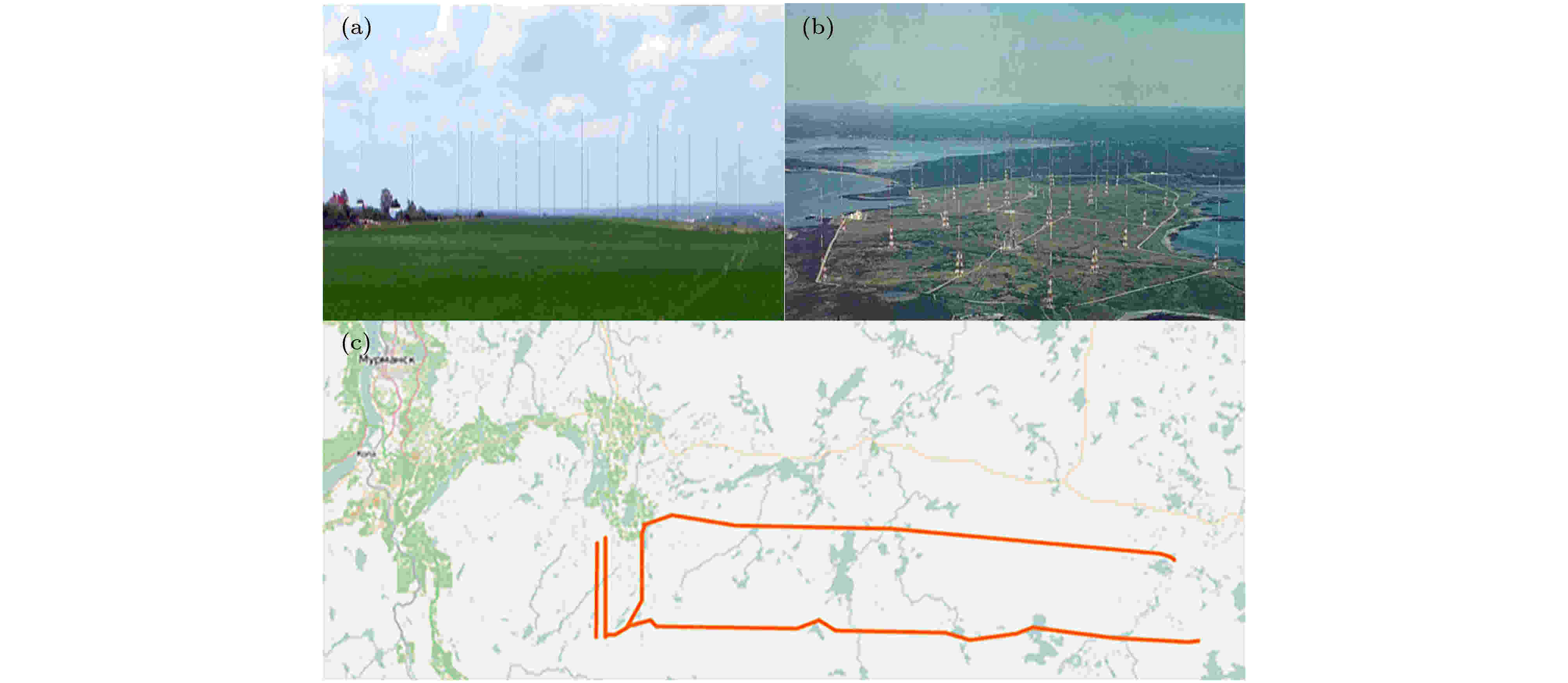
2020, 69 (20): 208401.
doi: 10.7498/aps.69.20200792
Abstract +
Low-frequency electromagnetic waves have the characteristics of long propagation distance, strong resistance to electromagnetic pulse interference, and slow attenuation in seawater and other media. However, conventional low-frequency transmitting antennas have problems such as bulkiness, high power consumption, and low efficiency, which are not conducive to the performance of low-frequency electromagnetic waves. The mechanical antenna is a new type of low-frequency transmitting antenna that generates time-varying electromagnetic field radiation through the mechanical movement of electric charges or magnetic dipoles. The new radiation principle enables mechanical antennas to break the constraints on the physical size of electromagnetic waves in the traditional antenna field, thereby achieving low-frequency communication with a smaller size and higher efficiency, providing a subversive solution to scenarios such as submarine communication and through-the-earth communication. In recent years, mechanical antennas have attracted much attention and become a hot research topic in the field of low-frequency communication. In this paper, we briefly review the development history, development direction, and existing problems of traditional large-scale land-based low-frequency transmit antennas and persistent mobile low-frequency transmit antennas; we mention the details of the working principles and recent research progress of different mechanical antenna implementations including electret, permanent magnet and piezoelectric mechanical antennas; we compare and analyze the radiation performance, innovations, advantages and disadvantages of each specific implementation scheme; and we also discuss the characteristics of the existing frequency modulation, amplitude modulation, polarization modulation and other signal modulation methods of mechanical antennas and the application schemes of several signal modulation methods of different types of mechanical antennas; finally, we prospect the research direction of mechanical antennas in the next stage. At present, the feasibility of the mechanical antenna scheme has been verified theoretically and experimentally, but it is limited by the antenna volume, power consumption, driving device and other factors, and the radiation intensity of the mechanical antenna is limited. We believe that the research in the field of mechanical antennas in the next stage will focus on the design of antennas for achieving longer communication distances at the sacrifice of certain small and light weight indicators, and innovative signal loading and modulation methods to improve communication rates will also be worth paying attention to in the field of mechanical antennas.
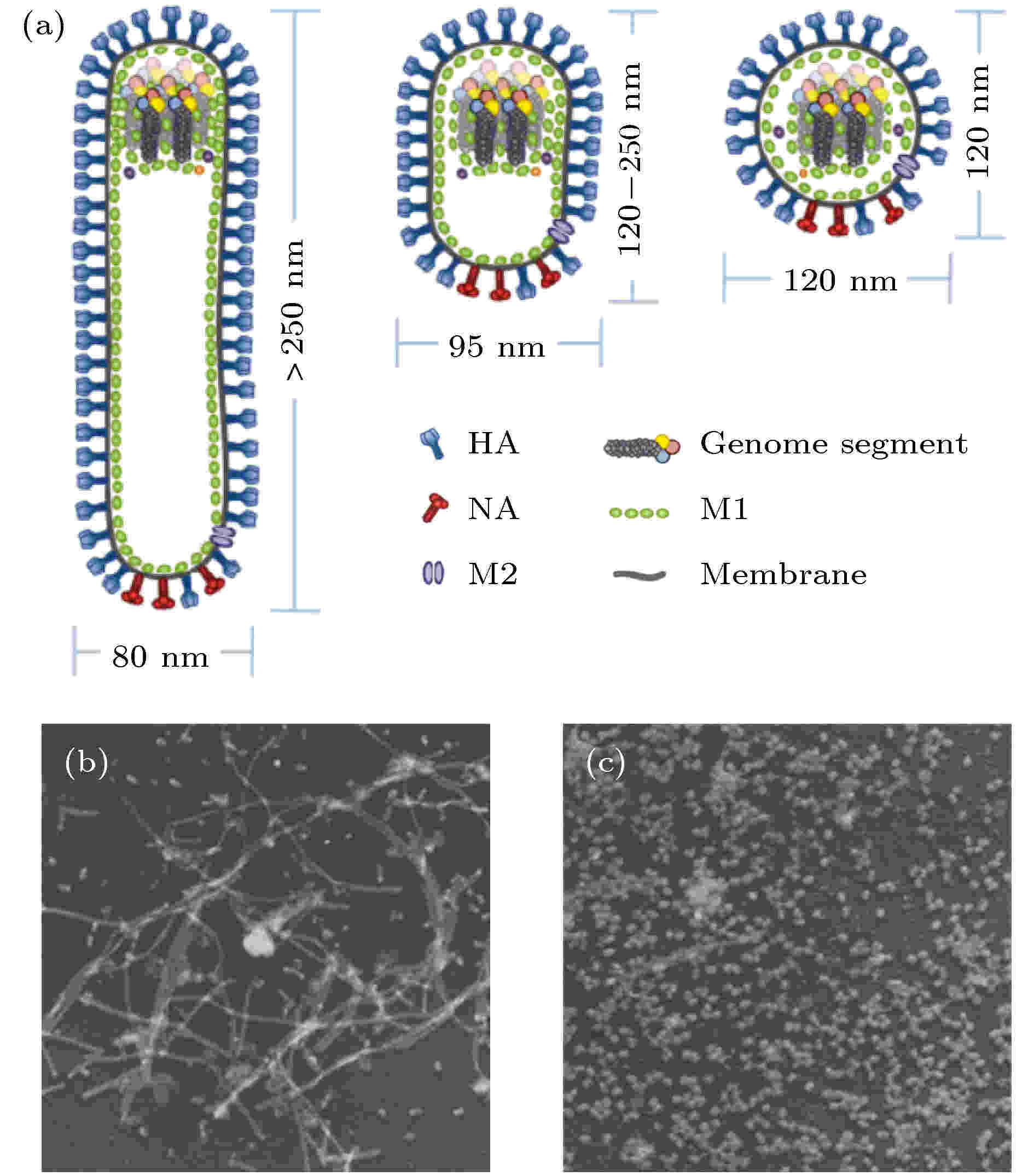
EDITOR'S SUGGESTION
2020, 69 (20): 208701.
doi: 10.7498/aps.69.20201161
Abstract +
Viruses are acellular organisms that must be parasitized in living cells and proliferated by replication. Although different viruses invade cells in different ways, they mainly initiate the invasion process through binding to specific receptor proteins or lipid structures on the cell surface for the following cellular internalization. Thus revealing the interaction process and underlying mechanism between viruses and cell membranes will be helpful in developing targeted drugs or vaccines from the source. In this review, the influenza virus and coronavirus are taken for example. We will first discuss the structure of influenza viruses, their binding modes with cell membranes, the way of realizing cell endocytosis and the cytokines involved in this process. After that, recent research progress of coronavirus especially the novel coronavirus SARS-CoV-2, including its structural characteristics, its binding with cell receptor ACE2 and the following cellular internalization, is briefly introduced.
GENERAL
2020, 69 (20): 200301.
doi: 10.7498/aps.69.20200799
Abstract +
A multi-party quantum key agreement protocol based on d-level multi-particle GHZ states is proposed. The “d-level” is common in other quantum cryptographic protocols, but there are few researches in the field of quantum key agreement. In our scheme, we introduce two indistinguishable orthogonal bases, i.e. the quantum Fourier transform and shift operation, into a d-level quantum system. In addition, we make full use of shift operation to encode the key into the sequence of quantum states, and the key can be measured by the d-level Z-basis. By decoding and calculating, each participant can equally extract other participants’ key and obtain the final shared key $ K = {K_0} \oplus {K_1} \oplus \cdots \oplus {K_{k - 1}}$ . The protocol resists external eavesdropping by inserting decoy states and conducting two security checks. Furthermore, we present an example by assigning certain values to parameters for illustrative purpose. Finally, QKA protocol mainly involves two types of attacks: participant attack and external attack. The external attack can be divided into Trojan attack, intercept-resend attack, and entangle-measure attack. To demonstrate the security of the scheme, we analyze the two types of attacks. The results show that the scheme can effectively resist the attack from internal participants and external eavesdroppers. However, the premise of our protocol is based on the ideal quantum channel. In practical applications, particles are usually affected by noise in the process of quantum channel transmission. Therefore, how the agreement adapts itself to a more complicated environment is our main work in the future.

2020, 69 (20): 200701.
doi: 10.7498/aps.69.20200552
Abstract +
As one of the key steps for data preprocessing of Raman spectra, baseline correction is an effective method to eliminate fluorescence interference. Traditional algorithms such as polynomial fitting and uniform B-spline fitting are simple and easy to implement, but the uncertain fitting order and internal knots limit their flexibility. In addition, the baseline correction results of traditional algorithms often occur over and under fitting phenomena. Therefore, we propose a baseline correction algorithm for Raman spectra based on median filtering and un-uniform B-spline. Firstly, the trough points of the spectral data are filtered by smoothing preprocess, difference calculation and threshold setting, and the internal knots of the un-uniform B-spline are adaptively selected by the trough positions of the spectral data. Then, the median filtering algorithm is used to process the spectral data so that the un-uniform B-spline has a better baseline fitting effect at the position where the signal changes from peak to smooth band. Finally, the un-uniform B-splines is used to fit the baseline by fitting the baseline iteratively. The proposed algorithm overcomes the shortcoming of traditional B-spline algorithm that the internal knots need to be selected manually based on different Raman spectra, and also avoids influencing the baseline fitting by random noise in the spectral data, and thus further improving the spectral baseline correction effect. The original Raman spectra of polymethyl methacrylate and normal octane are used for experimentally evaluating the baseline correction effect. Compared with the results from polynomial fitting, uniform B-spline and adaptive iteratively reweighted penalized least squares algorithms, the experimental results show that the proposed algorithm can well eliminate the Raman signal baseline drift effectively without over or under fitting phenomena, and it can perform better baseline correction for different baseline drift situations. Therefore, the proposed algorithm can provide more accurate and reliable information for the further analysis of spectral data.
ATOMIC AND MOLECULAR PHYSICS
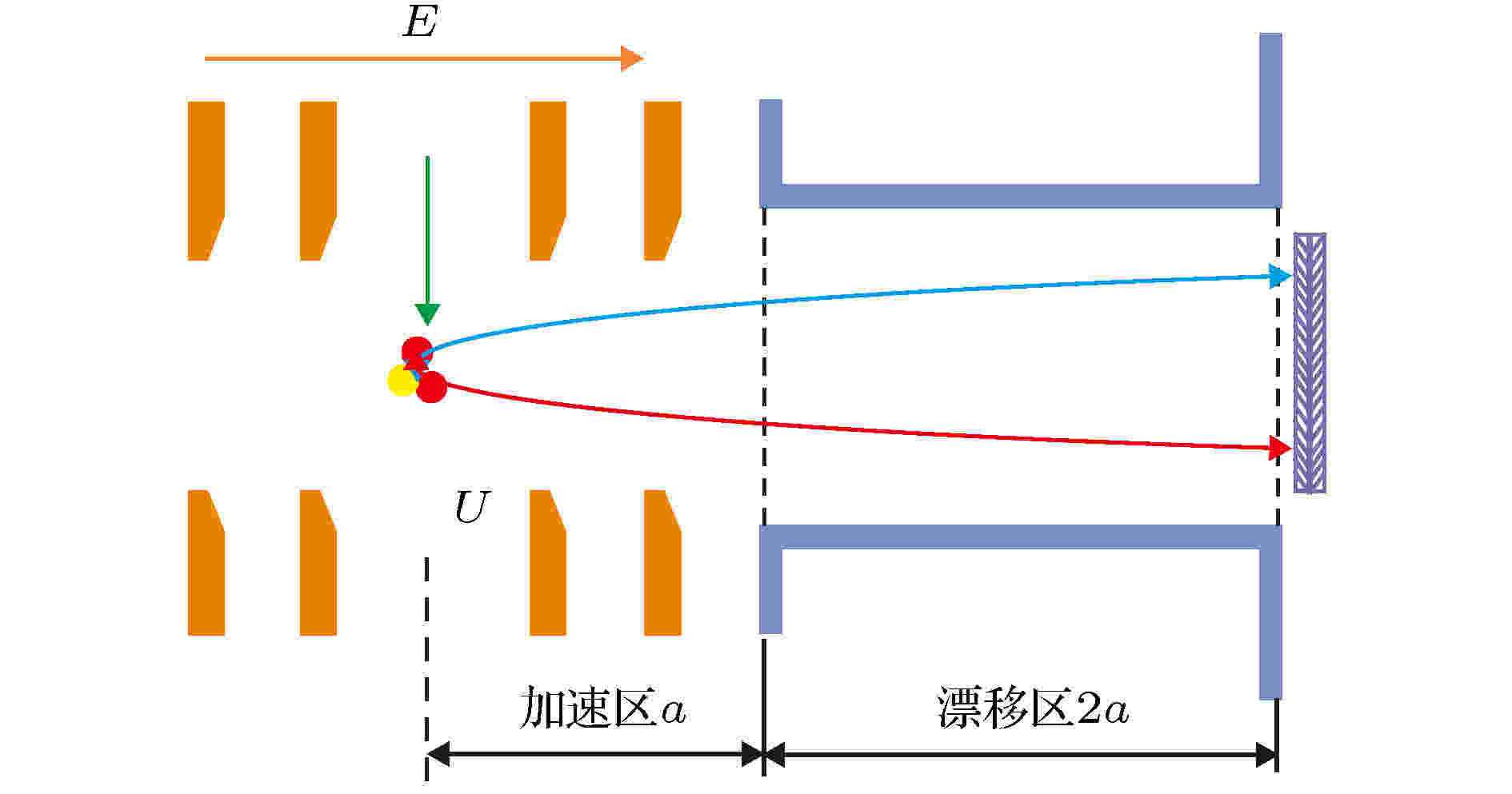
2020, 69 (20): 203401.
doi: 10.7498/aps.69.20200901
Abstract +
In the studies of fragmentation processes of molecules induced by extreme ultraviolet photons, intense laser fields, or charged particles, kinetic energy release (KER) is a key physical parameter. It can reveal the electronic states of the parent molecular ion, and provide an insight into the molecular structures and the dissociation dynamics. Therefore, it is essential to obtain the accurate KER spectrum for studying the fragmentation process of molecules. However, in the experiments using reaction microscope, experimental parameters such as the time-of-flight (TOF), the voltage of the TOF spectrometer and the detector image of the fragments have significant influence on the accuracy of KER determination. In this work, by taking the two-body fragmentation process of CO2+ → C+ + O+ induced by 108 keV/u Ne8+ impact on CO molecules as a prototype, we introduce two methods to accurately calibrate the reconstructed KER spectrum. The first method is to employ two-dimensional momentum spectra of C+ ions obtained by slicing the momentum sphere. The parameters are correctly calibrated when the circular distribution of the two-dimensional ion momentum image is restored. The second method is to use the correlation spectra of the KER as a function of the emission angle of the C+ ions to calibrate the experimental parameters, the calibration meets the required level only when the linear dependence of the emission angle on the KER is fulfilled. Then, calibrated KER spectrum is obtained for the dissociation process. By fitting the peak dissociated from the $^{3}\Sigma^{+}$ state of CO2+ in the KER spectrum, the energy resolution is estimated at 0.24 eV under these experimental conditions. Although these two methods can be used to accurately calibrate the reconstructed KER spectrum, the second calibration method does not require particularly high data statistics, and is suitable for analyzing the processes with lower reaction cross section. Furthermore, this method is convenient for debugging the parameters. Both methods are reliable for parameter calibration and guarantee high accuracy KER for molecular fragmentation experiments in future.
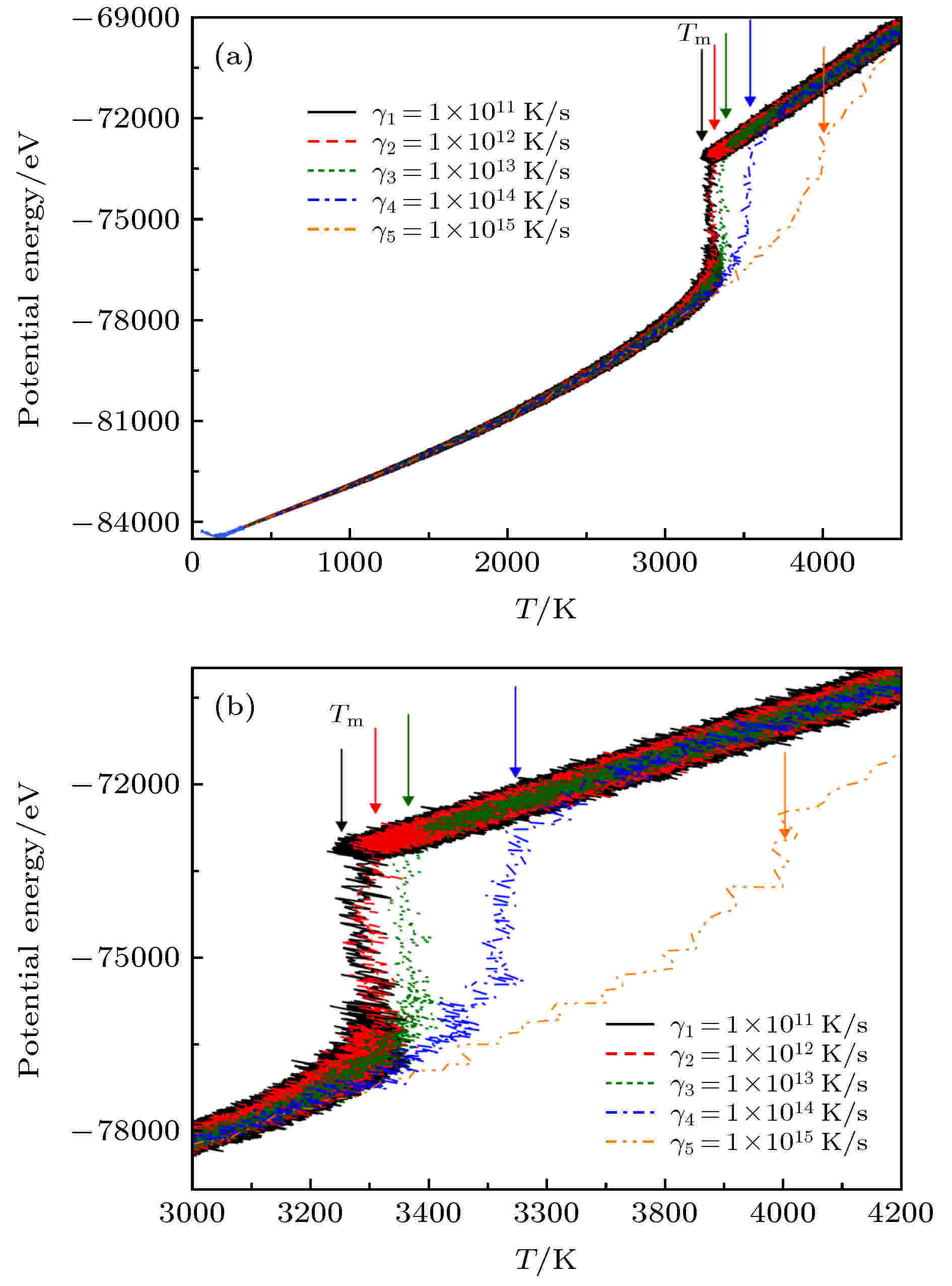
2020, 69 (20): 203601.
doi: 10.7498/aps.69.20200185
Abstract +
By using large-scale atomic/molecular massively parallel simulator (LAMMPS) code, a molecular dynamics simulation is performed in the NPT ensemble at zero pressure to investigate the influence of melting rates γ on the evolutional characteristics of vanadium atomic structure such as body-centered cubic (BCC), hexagonal close-packed structure (HCP), face centered cubic (FCC), simple cubic (SC) and icosahedra (ICO) during the rapid melting of solid vanadium crystal at five different melting rates (γ1 = 1 × 1011 K/s, γ2 = 1 × 1012 K/s, γ3 = 1 × 1013 K/s, γ4 = 1 × 1014 K/s , γ5 = 1 × 1015 K/s), in which 16000 atoms in a cubic box under the periodic boundary condition are considered, and their motion equations are solved by Verlet’s algorithm in the velocity form in time steps of 1 fs. Constant pressure P and temperature T are imposed by a modified Nose-Hoover method for both P and T variables, and an embedded-atom model (EAM) potential is utilized. For identifying the local atomic structures of liquid and solid vanadium at different temperatures, a polyhedral template matching method (PTMM) is used by measuring the root-mean square deviation (RMSD), in which clusters are classified as the topology of the local atomic environment without any ambiguity in the classification. Subsequently, the variation of the potential energy, entropy and Gibbs free energy of FCC, HCP, BCC and ICO vanadium clusters are calculated through ab initio MD simulation in the canonical ensemble (NVT) at selected temperatures, and the lowest-energy dynamic structure and its corresponding static heating structure are also shown in this paper. Based on the above calculated results, it is found that the melting point of refractory metal vanadium increases obviously with the increase of heating rate, but the heating rate only presents a limited effect on the population of atomic structure for each of BCC, HCP, FCC, SC and ICO. Namely, the temperature still plays a dominant role in the rapid melting process of V rather than heating rate. Moreover, the ab initio MD simulation and thermodynamics analysis further reveal that lots of ICO clusters of vanadium can exist stably in the liquid region rather than in solid crystal, which is not only due to its higher stability and longer lifetime than those of crystalline atomic clusters, but also because ICO possesses higher entropy and lower Gibbs free energy in high temperature liquid region.
ELECTROMAGNETISM, OPTICS, ACOUSTICS, HEAT TRANSFER, CLASSICAL MECHANICS, AND FLUID DYNAMICS

2020, 69 (20): 204101.
doi: 10.7498/aps.69.20200606
Abstract +
Frequency selective surface (FSS) is of great research interest for its wide applications in radome, absorber, electromagnetic filters, and artificial electromagnetic bandgap materials. In order to achieve a multifunctional FSS with real-time manipulated radar cross-section (RCS), there are mainly three ways, i.e. to design reconfigurable FSS unit cell, reconfigurable screen, and a combination of reconfigurable unit cell and screen. In this work, a combination design of both the reconfigurable unit cells and FSS screen is proposed to realize a dual-band FSS absorber with real-time manipulated RCS. For the reconfigurable unit cell, an angular ring and a meander cross dipole are combined to obtain a dual-band absorption. The dual-band resonance frequencies are reconfigurable by switching the PIN diodes embedded in the unit cell. When switching the PIN diodes, the resonance frequencies of the unit cell would be changed due to the variation of the effective capacitance and inductance of the unit cell. For the reconfigurable FSS screen, a novel biasing network is introduced, then the scattering field from each unit cell is modulated independently by switching the “on/off” state of the PIN diode through using a programmable field programmable gate array (FPGA). The total scattering far field is expressed as the superposition of the scattering field from each unit cell, and the far field scattered by the unit cell which is evaluated under an infinite periodic boundary condition. The scattering field of the FSS absorber can be predicted by considering the working states of all the unit cells on the screen. We define the unit cell as state “0”, when all the PIN diodes are at the states of “off”, and as state “1” when the PIN diodes are all at the states of “off”. The entire screen of FSS absorber is thus pixelated, which can be expressed by a binary coding matrix. The real-time scattering fields from the FSS absorber are manipulated perfectly by optimizing the states matrices showing “on/off” of each unit cell with genetic algorithm (GA). The FSS absorber is fabricated and measured. The ranges of 33dB and 25dB reconfigurable monostatic RCS at 3.2 GHz and 10.3 GHz are achieved by coding the states of unit cells on the FSS absorber screen. Both full-wave and analytical simulations demonstrate the effectiveness of the proposed optimization procedure. Compared with the reported FSS absorber, the proposed design is validated to possess good performance.
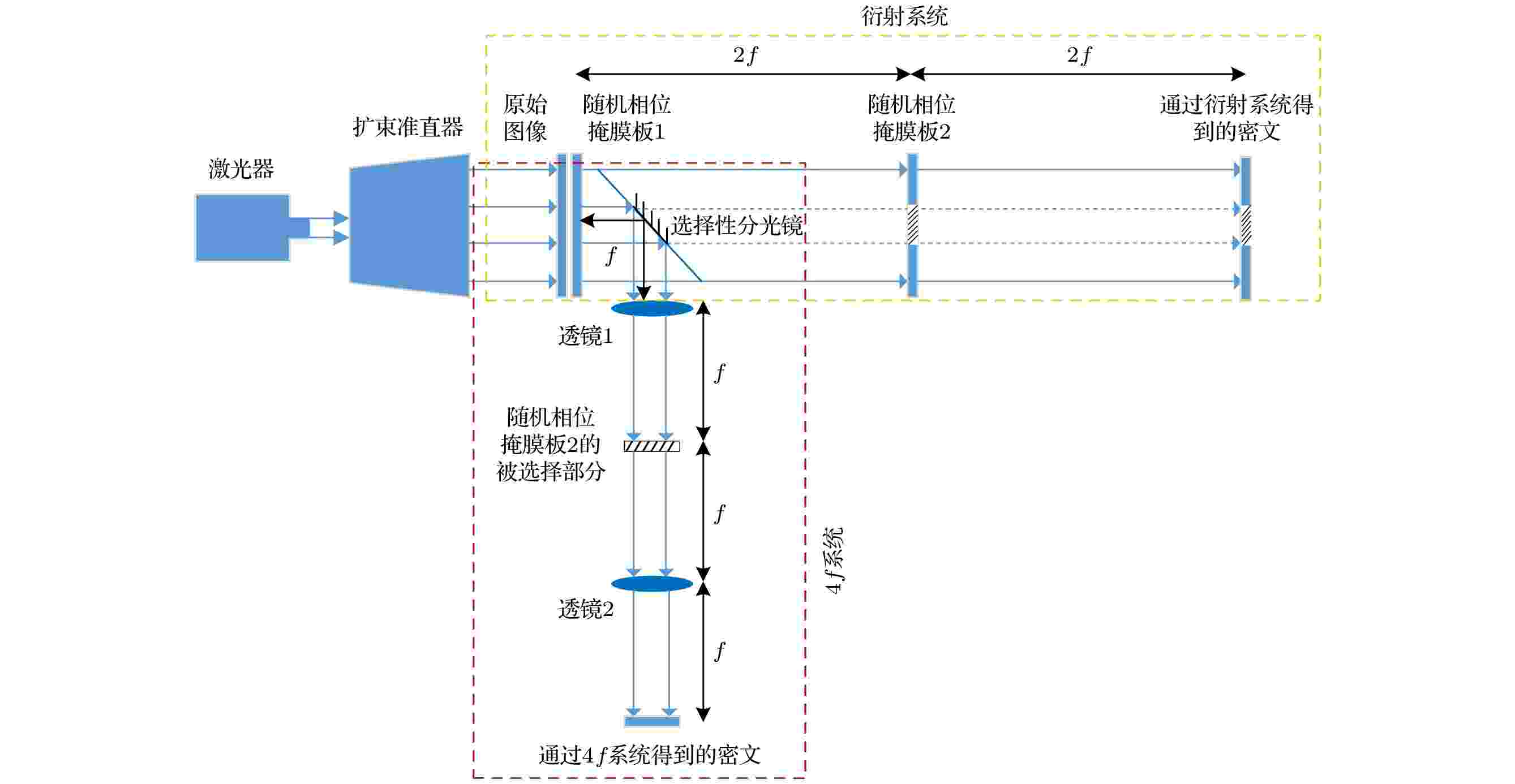
2020, 69 (20): 204201.
doi: 10.7498/aps.69.20200478
Abstract +
Most of the existing selective encryption schemes are based on image processing and cannot be realized by optical structures, so their practicality is limited. Combining the optical design, a local hybrid optical encryption system based on double random phase encoding is proposed. The system proposed in this paper possesses a common aperture and dual optical path structure, which is widely used in optical design and can effectively improve the practicality of optical encryption system. First, important information and non-important information in the original image are separated by a selective beam splitter. Then light waves carrying important information enter into the 4f system for encryption, and light waves carrying non-important information enter into the diffraction system for encryption. Finally, part of the diffraction system ciphertext is replaced with 4f system ciphertext to obtain the final encrypted image. Decryption is the reverse process of encryption. First, the 4f system ciphertext is cut out from the final ciphertext. Then the 4f system ciphertext is used to restore the information replaced in the diffraction system ciphertext, thereby obtaining the complete diffraction system ciphertext. Finally, the two ciphertexts go through the reverse process of their respective systems to complete the decryption. By comparing the statistical characteristics and mean square error of the original image and the encrypted image, the effectiveness of the proposed system's encryption process is proved. By analyzing the peak signal-to-noise ratio of the original image and the decrypted image, the effectiveness of the proposed system's decryption process is proved. The sensitivity of each key of the system is analyzed to prove the security of the system. Especially the system is highly sensitive to selective encryption key, which proves the effectiveness and security of the proposed system for selective encryption. Through simulation, it is verified that the proposed system is very resistant to diffraction attacks. Even if he can obtain all the diffraction keys, the attacker still cannot obtain the selectively encrypted information. Finally, through simulation, it is verified that the proposed system has good noise resistance and crop resistance, and high robustness as well. The proposed system can realize the selective encryption through optical structure, which is safe, effective and highly robust, and thus improving the practicality of selective optical encryption system.
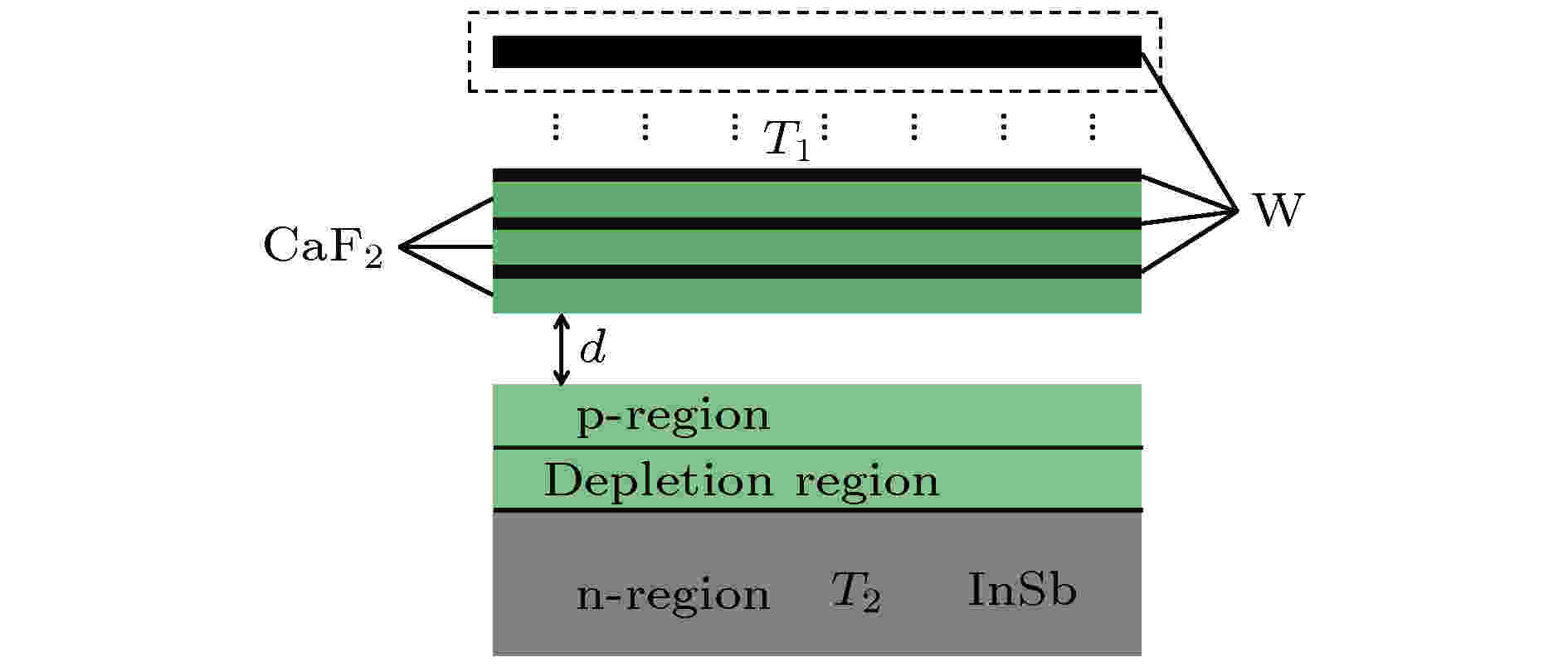
2020, 69 (20): 204203.
doi: 10.7498/aps.69.20200892
Abstract +
Thermophotovoltaic (TPV) device is a thermoelectric conversion method with great application prospects. In the far-field regime, the thermoelectric power is usually small due to the Planck blackbody radiation limit, but can be substantially enhanced in the near-field regime where evanescent waves will participate in the heat transfer by tunneling. In this aspect, the surface optical density of state is a key factor that will determine the transfer conversion of thermal photons. Plasmonic or phononic resonance materials have been discussed in the literature to acquire large heat flux. Besides, metamaterial is another way to pursue the design freedoms for the same purpose. In this work, we propose a [CaF2/W]n multilayer based infrared hyperbolic metamaterial (HMM) with high surface density of states as an emitter of a high-performance TPV cell made of an InSb p-n junction (energy bandgap = 0.17 eV). The effective medium theory (EMT) is utilized to describe the electromagnetic behavior of the HMM. The near-field heat flux is calculated based on electrodynamic wave theory and Green's function method, and the photocurrent of thermophotovoltaic device is derived using diffusion equation for semiconductor. For comparison, we design three different radiators, i.e. tungsten film (W), [GaF2/W]n multilayer hyperbolic metamaterial (HMM), and tungsten-grounded HMM (WHMM). Compared with the pure tungsten radiator, the artificial structure exhibits the hyperbolic dispersion characteristic in a wide frequency range, which gives rise to a higher local density of states, in particular in the hyperbolic-to-elliptic spectral transition region. As a result, the radiation power and the energy conversion efficiency are greatly enhanced, which are more easily realized by a matched emission band achieved by the structural design. We find that the thermophotovoltaic device with WHMM radiator has a similar power and conversion efficiency to that with the HMM radiator. The influence of the substrate can be ignored when the hyperbolic metamaterial is thicker than 140 nm, very beneficial to the actual fabrication of the device. By our system, with multilayer hyperbolic metamaterial (HMM) radiator, a high electric power >1 W/m2 and a conversion efficiency about 11% can be obtained at a bias temperature of 200 K and a 100 nm vacuum gap. Compared with nanowire arrays or natural hyperbolic material, the multilayer structure proposed in this paper has obvious advantages in bandwidth and manufacturing and may find important applications in near-field thermophotovoltaic device and other relevant areas.
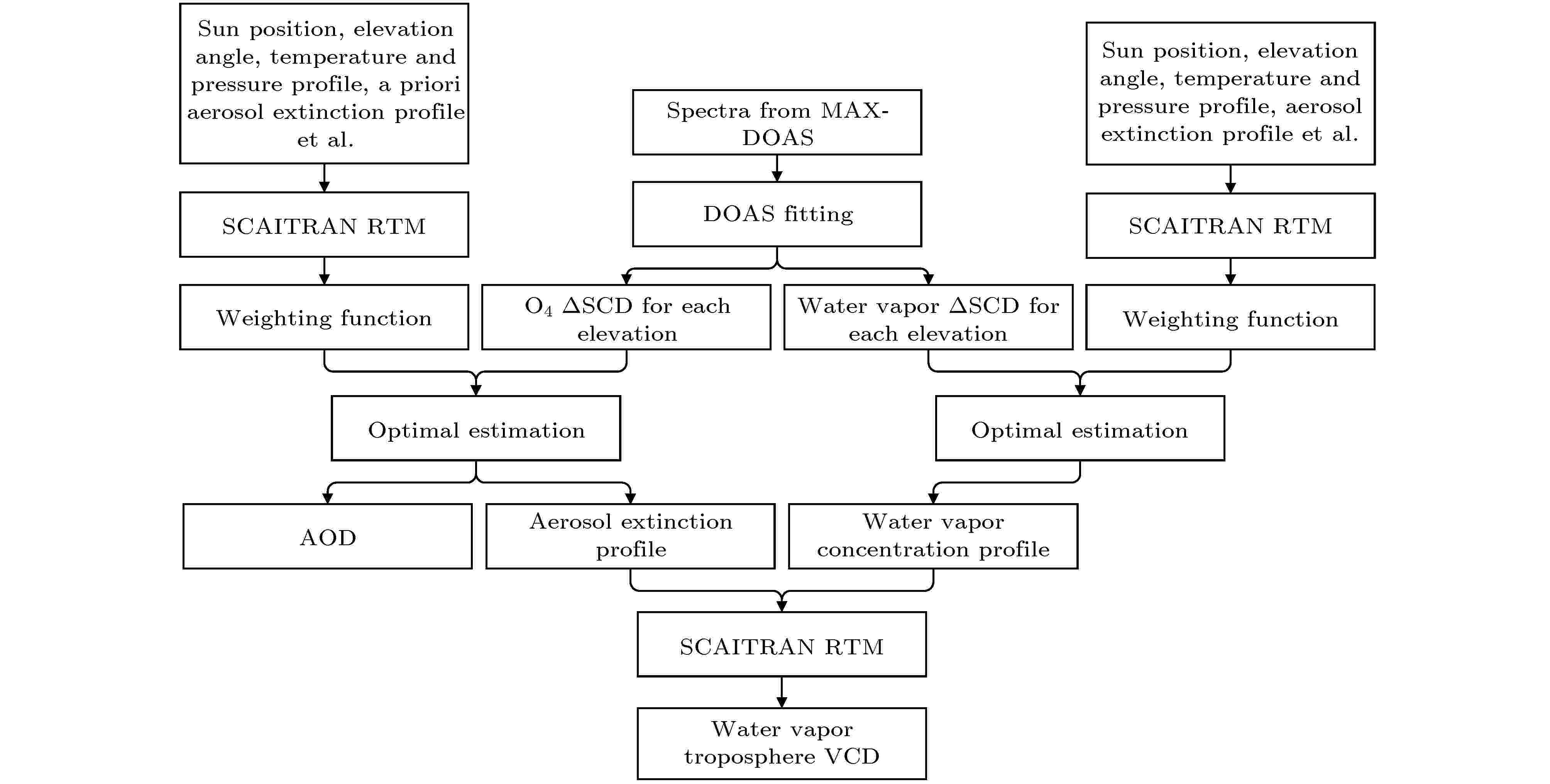
2020, 69 (20): 204204.
doi: 10.7498/aps.69.20200588
Abstract +
The method of retrieving the vertical column density (VCD) and the atmospheric vertical profile of water vapor in visible blue band (434.0–451.5 nm) were studied by using the multi-axis differential optical absorption spectroscopy (MAX-DOAS). First, the method of retrieving the VCD of water vapor was studied. Owing the the fact that the water vapor absorption cross section is of high resolution and it cannot be effectively measured by MAX-DOAS, a convolved cross section with the instrument slit function was used. In addition, the correction factor for water vapor saturation absorption was also used to obtain the true VCD. Second, the water vapor profile retrieved by applying the nonlinear optimal estimation of the trace gas retrieval method (PriAM) was studied, including the effects of aerosol state and the priori profile on the water vapor retrieval. Influence on the water vapor retrieval from the aerosol prior profile linear changes was unapparent. High aerosol state has a significant influence on the water vapor profile retrieval and it was still within the total error tolerance. This indicates that the PriAM is applicable in the water vapor profile retrieval. Using this method, a continuous observation experiment was carried out at the MAX-DOAS Aoshan regional station in Qingdao. The retrieved water vapor VCD results were compared with the daily average data of the European Centre for Medium-Range Weather Forecasts (ECMWF), and the R2 is 0.93. The comparison of the near-surface water vapor concentration of MAX-DOAS retrieval with the ECMWF and sounding data of the University of Wyoming shows that R2 is larger than 0.70 and 0.66, respectively. The two comparison results demonstrate that PriAM can retrieve the atmospheric water vapor VCD and profile accurately. The vertical distribution characteristics of water vapor in Qingdao was analyzed, and the profile results show that the concentration of water vapor in Qingdao was distributed mainly under 1.5 km in height.
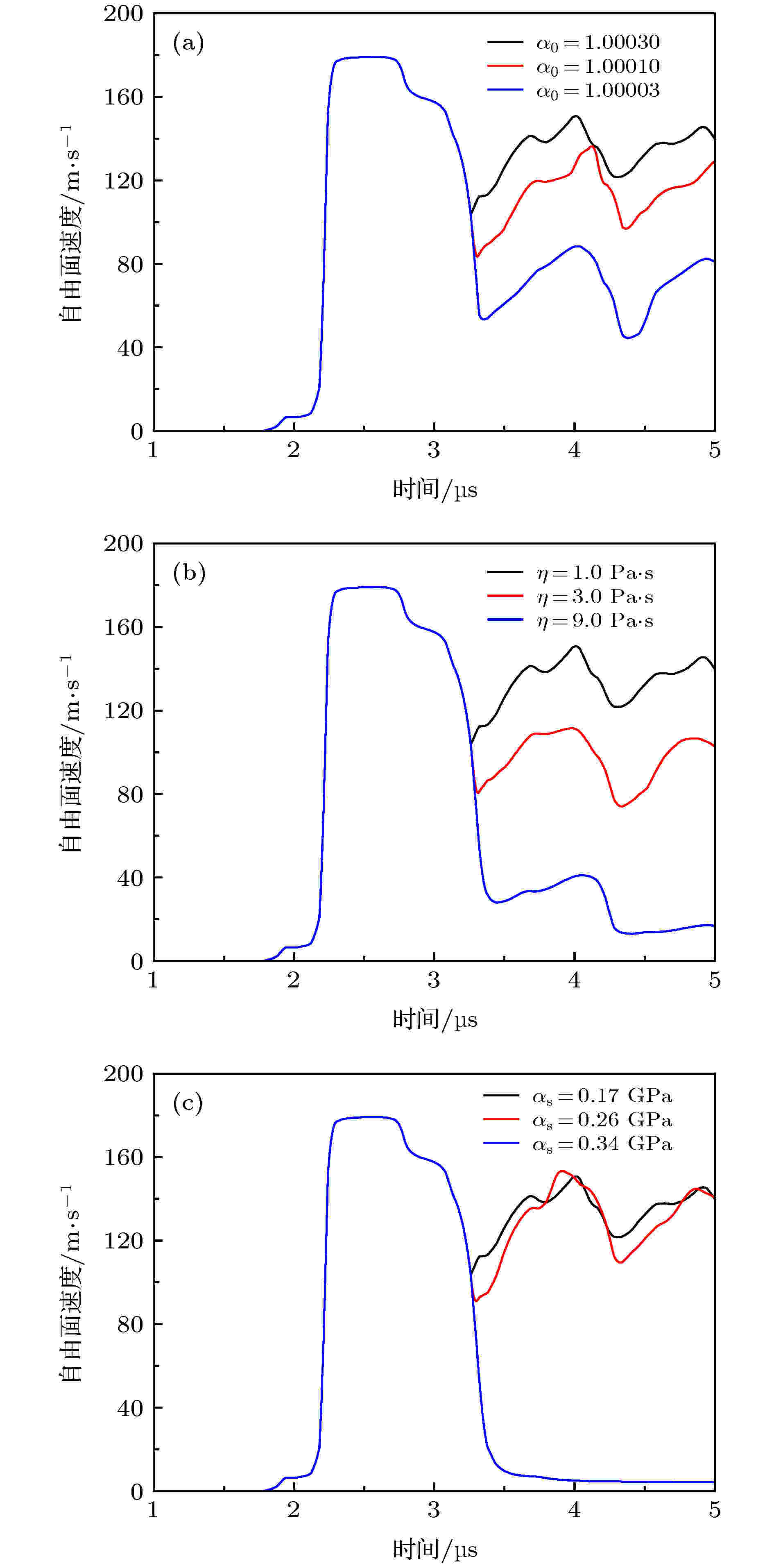
2020, 69 (20): 204601.
doi: 10.7498/aps.69.20200527
Abstract +
Spallation of ductile metal is of great importance in many scientific and engineering fields, which is due to the interaction between the incident shock waves and the reflected waves. Physically, the spallation is caused by nucleation, growth and coalescence of microvoids for ductile material. Therefore, numerical simulation of spall process usually involves theoretical model of void growth. However, due to the limited knowledge of microvoid properties, many empirical parameters are included in the void growth model, which are usually determined by comparing numerical results with experimental data. Therefore, a key problem arises in the numerical modeling of damage and spall fracture, that how the parameters of the void growth damage model can be determined. In this work, we present a theoretical method to determine the parameters based on the free surface velocity (FSV) profile. Firstly, the critical state of damage is discussed based on the relationship between characteristics of FSV and change of physical quantity in spall plane. Then, the propagation and interaction of shock waves during the evolution of spall damage are considered. Lastly, the physical meanings of the parameters of the void growth damage model are further discussed. So, based on the relation among spall strength, damage and pull-back of FSV, a physics-based method to determine the parameters of the model is given. The applicability of this method is verified by the simulation of the spall experimental data on typical ductile metals OFHC copper and tantalum. The parameter-determining method given in this paper can not only expand the scope of application of the damage model and effectively improve the reliability of the calculation results, but also provide a good reference for the determination of parameters of other spall damage model.
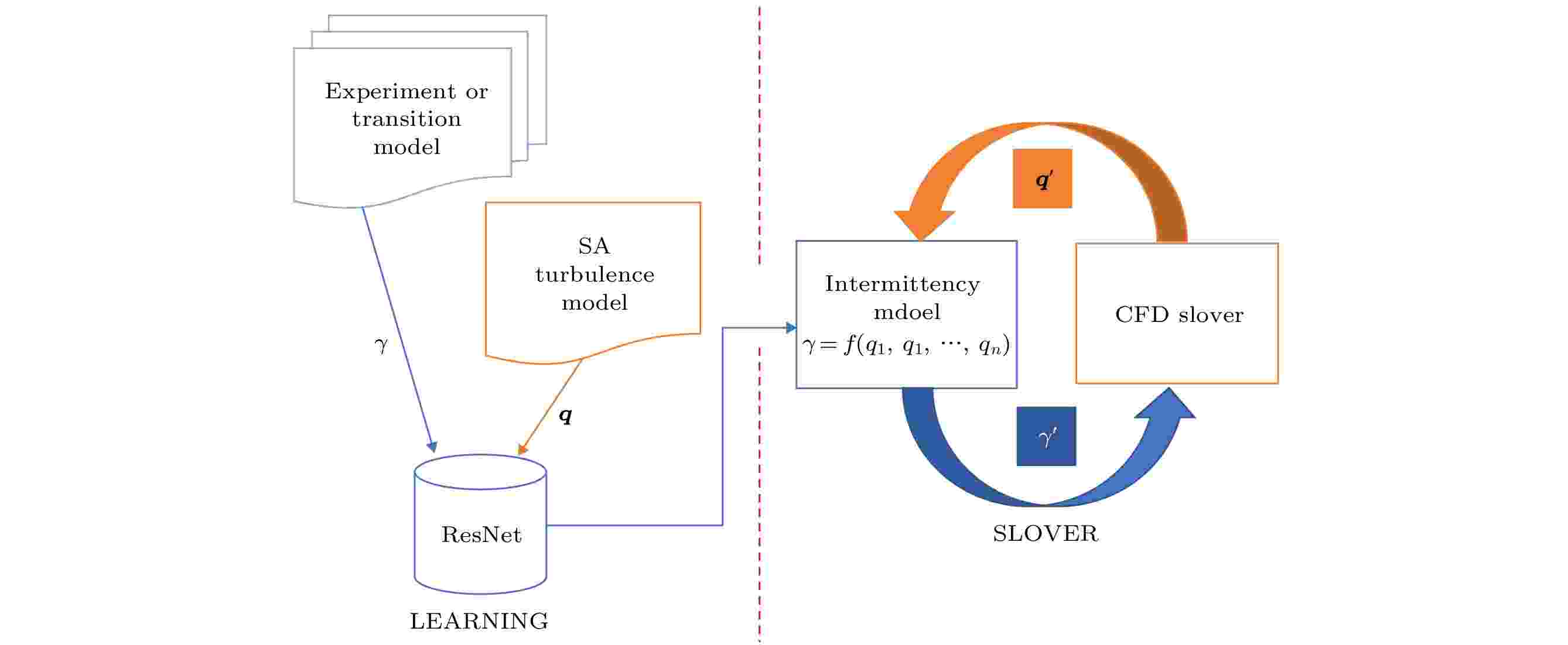
2020, 69 (20): 204701.
doi: 10.7498/aps.69.20200563
Abstract +
Turbulence model combined with machine learning is one of the research hotspots in fluid mechanics. The existing approaches reconstruct or modify the turbulence eddy viscosity or Reynolds stress based on the experimental/numerical data. In this paper, we reconstruct the mapping function between intermittency and the mean flow variables by deep neural network (ResNet), developing an quasi-algebraic transition model coupled with the Spallart-Allmaras (SA) model. We mainly concentrate on the natural transition flows and take the results calculated by the computational fluid dynamics solver with the SST-γ-Reθ model as the training data. Seventeen local mean flow quantities satisfying the Galilean invariants are selected as the input features. Five-time cross validation is performed to avoid overfitting. Combining with the high-precision weighted compact nonlinear format, S&K, T3a- transition plate and S809 airfoil are used to test the performance of the model. The results are compared with those from the SST-γ-Reθ transition model, showing that the pure data-driven ResNet model can predict the intermittent field accurately, which greatly improves the ability of SA model to simulate the natural transition flow. For the example of S&K and T3a- transition plate, the comparison of wall friction shows that the SA-ResNet model is in good agreement with the experimental result, but the BC model, which is also an algebraic model, predicts the transition position of the T3a- transition plate model prematurely. The training data do not contain any numerical solution about airfoil, but the model can still be applied to the case of S809 airfoil with different attack angles. The predicted results of lift resistance characteristics, frictional coefficient distribution and transition position are close to the results from the SST-γ-Reθ transition model. On this basis, another advantage of the model is the solution efficiency. The efficiency is improved more significantly in the case with larger mesh quantity. With the same convergence accuracy, the CPU time required by the SA-ResNet model for the S&K plate case is 85.6% that of the SST-γ-Reθ transition model, while the CPU time required by the S809 airfoil with a larger mesh volume is only 67.2% that of the later model. This study demonstrates the great potential of machine learning in the construction of transition models.

2020, 69 (20): 204702.
doi: 10.7498/aps.69.20200602
Abstract +
CONDENSED MATTER: ELECTRONIC STRUCTURE, ELECTRICAL, MAGNETIC, AND OPTICAL PROPERTIES

2020, 69 (20): 207101.
doi: 10.7498/aps.69.20200843
Abstract +
The circular dichroism of chiral structure has been widely used in analytical chemistry, industrial pharmacy, biological monitoring, etc. However, the light-matter interaction between natural chiral structures is extremely weak. Plasmonic nanostructures can significantly enhance light-matter interaction. During the fabrication of the visible-to-near-infrared chiral plasmonic metamaterial absorbers, there exists usually a trade-off between the absorption and the sample area, that is, the circular dichroism signal of the large-area structure is small. Besides, the preparation of chiral absorbers working in the visible and near-infrared region usually requires expensive etching or lithography equipment, such as reactive ion etching or electron beam lithography. Therefore, preparing cost-effective chiral absorbers with large circular dichroism is attractive for practical applications. In order to improve the circular dichroism of large-scale chiral absorbers, a honeycomb-shaped elliptical hole absorber is proposed in this paper, and its absorption, circular dichroism, and optical g-factor are studied. By reasonable design, the numerical calculation results show that the circular dichroism can reach about 0.8 under the excitation of chiral polarized light, and the corresponding optical g-factor can reach about 1.7 at 920 nm. Compared with the reported absorber, our chiral absorber has a maximum g-factor value. The giant circular dichroism originates from the symmetry breaking of the structure by tilting ellipse structures, and the tilt angle has a significant influence on circular dichroism. To further explain the absorption difference, the electric profile, surface current distribution, and absorption loss of the chiral absorption at resonant wavelength are analyzed. Finally, we point out that the structure can be prepared by existing technologies, such as nanosphere photolithography: first, a layer of polystyrene (PS) balls is formed by self-organization, which can control the period of the structure; then the size of the PS balls is reduced to a suitable size and spacing by the reactive ion etching; finally, a metallic layer is deposited by oblique angle evaporation. This work provides useful guidance for fabricating the large-scale chiral plasmonic absorbers.
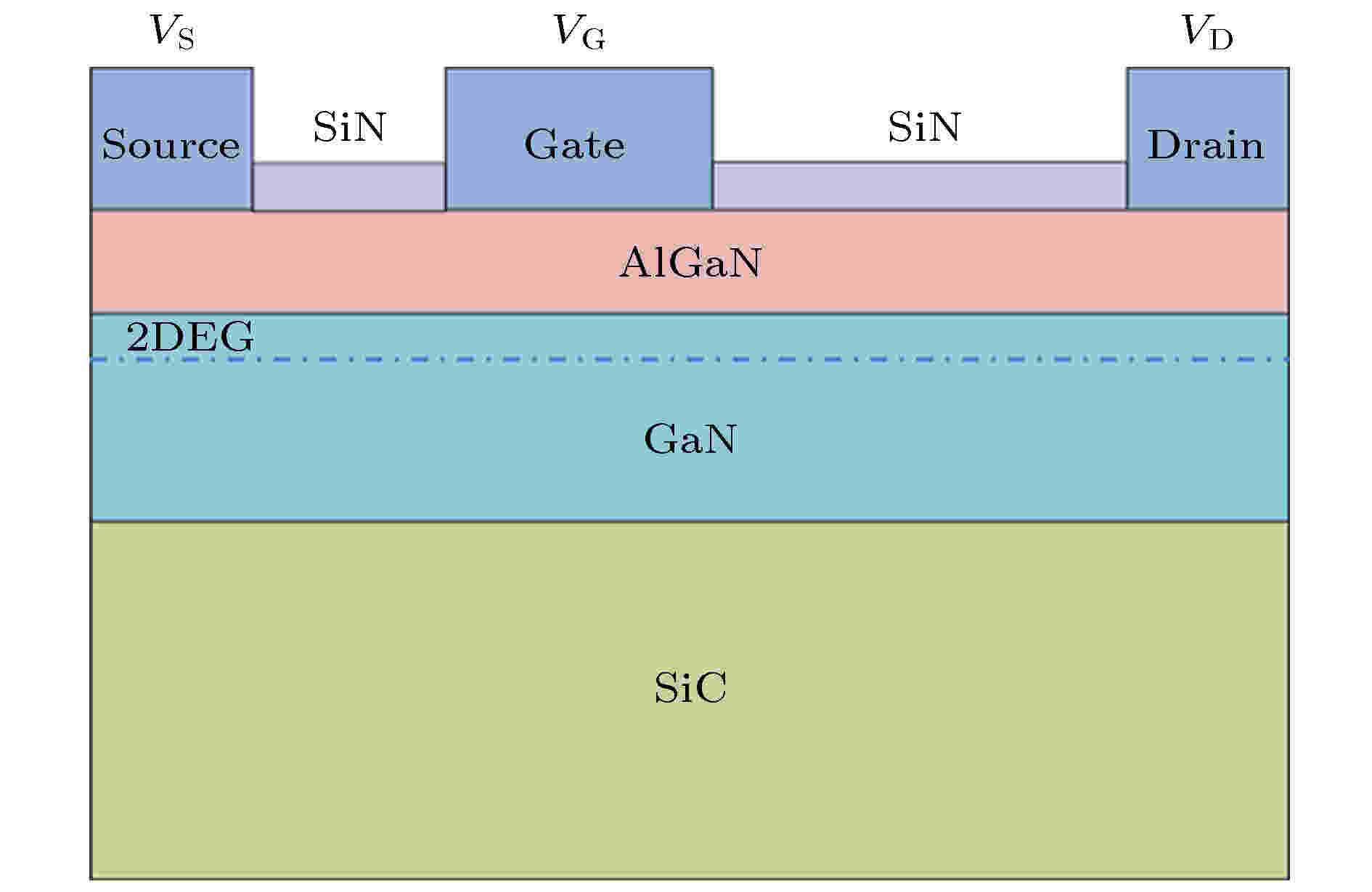
2020, 69 (20): 207301.
doi: 10.7498/aps.69.20200714
Abstract +
In this paper, neutron-induced displacement damage effects of AlGaN/GaN High electron mobility ransistor (HEMT) device and heterostructure on the Xi’an pulse reactor are studied. The equivalent 1 MeV neutron fluence is 1 × 1014 n/cm2. The direct-current characteristics and low frequency noise characteristics of the HEMT deviceare used to characterize the performances before and after being irradiated by the neutrons, and then the experimental results are analyzed theoretically. The analysis results showed that the displacement damage effect caused by the neutron irradiation will introduce the bulk defects into the device. The bulk defects at the channel cause the electrical performance of the device to degrade through trapping electrons and scattering electrons, which are mainly manifested as the drift of positive threshold voltage, the decrease of output saturation drain current, and the increase of gate leakage current. In order to further confirm the effect of neutron irradiation on the defect density of the device, we implement the low-frequency noise test and the calculation of the device, and the results show that the defect density at the channel of the device increases from 1.78 × 1012 cm–3·eV–1 to 1.66 × 1014 cm–3·eV–1, which is consistent with the results of the electrical characteristics test, indicating that the new defects introduced by neutron irradiation do degrade the electrical performance of the device. At the same time, the capacitor-voltage test is also carried out to analyze the Schottky heterojunctions before and after neutron irradiation. It is found that the channel carrier concentration is significantly reduced after irradiation, and the flat band voltage also drifts positively. The analysis shows that after irradiating the device with neutrons, a large number of defects will be generated in the channel, and these defects will affect the concentration and mobility of the channel carriers, which in turn will influence the electrical performance of the device. These experimental results can be used for designing the AlGaN/GaN high electron mobility transistor for radiationhard reinforcement.
INTERDISCIPLINARY PHYSICS AND RELATED AREAS OF SCIENCE AND TECHNOLOGY

2020, 69 (20): 208402.
doi: 10.7498/aps.69.20200793
Abstract +
As the age of the internet of everything begins, the demand for various sensors to communicate with each other is soaring. As the lifeblood of the sensing system, reliable energy supply is the key consideration. Environmental mechanical energy harvesting has been a key technology for self-powering sensing system, which can convert mechanical energy into electric energy. Here, we present a non-resonant triboelectric-electromagnetic hybridized nanogenerator, which can scavenge low-frequency vibration energy from environmental vibration. In the device a rotating gyro is used as a core component. An embedded magnet and four coils arranged evenly around at the bottom of the shell form an electromagnetic generator (EMG), and a piece of triboelectric film pasted on the outer surface of the gyro together with a bottom electrode constitutes a triboelectric nanogenerator, (TENG). With the design of rotating gyro, a high sensitive energy capture can be realized under low frequency and irregular vibration. Under the rotation and revolution of the gyro, the triboelectric and electromagnetic energy will be generated. Through theoretical analysis and software simulation, the working principle of the device is expounded. Based on a linear motor platform, the influences of oscillation frequency and amplitude are systematically studied, and the maximum power of 0.084 mW under a loading resistance of 20 MΩ and 4.61 mW under 800 Ω are obtained at a driving frequency of 2 Hz by the TENG and EMG, respectively. The energy conversion efficiency of the system is 0.45%. Moreover, by placing the devices on the legs and arms of the human body respectively, the ability of the hybridized nanogenerator to capture the simple movement energy of the human body is further verified. After that, a self-powering pedometer module is successfully integrated with the energy storage unit. Under the excitation provided by running a body, the hybridized nanogenerator can provide a 20-s pedometer normal operation after charging a capacitance of 100 μF to 3.2 V. This research not only provides a new idea for the efficient acquisition of vibration energy, but also has potential applications in the energy supply of self-powered sensors.

EDITOR'S SUGGESTION
2020, 69 (20): 208502.
doi: 10.7498/aps.69.20201297
Abstract +
The high/low conductance switching in stretching process of 4,4′-bipyridine molecular junction is a distinctive phenomenon in molecular electronics, which is still a mystery and has been unsolved for more than one decade. Based on the techniques and processes of experimental measurement, the ab initio-based adiabatic molecule-junction-stretch simulation (AMJSS) method is developed, by which the stretching processes of 4,4′-bipyridine molecular junctions are calculated. The conductance traces of the molecular systems in the stretching processes are studied and the mystery of high/low conductance switching in the stretching processes of 4,4′-bipyridine molecular junction is decoded by using the one-dimensional transmission combined with the three-dimensional correction approximation (OTCTCA) method. The numerical results show that, in the stretching process of 4,4′-bipyridine molecular junction, the upper terminal nitrogen atom in the pyridine ring is easy to vertically adsorb on the second gold layer of the probe electrode. At the same time, the molecule produces unique lateral-pushing force to push the tip atoms of the probe electrode aside. Thus, the high conductance plateau arises. With the molecular junction further stretched, the upper terminal nitrogen atom of the molecule shifts from the second gold layer to the tip gold atom of the probe electrode with the tip gold atom moving back to the original lattice position. Consequently, the conductance value decreases by about 5–8 times, and the low conductance plateau is presented. According to our calculations, the phenomenon of high/low conductance switching in the stretching process of 4,4′-bipyridine molecular junction also indicates that, single surface gold atom often lies on the surface of substrate electrode. Moreover, the phenomenon of high/low conductance switching can only be found when the molecule is adsorbed on the surface gold atom of the substrate electrode. Thus, using conductance traces measured in the stretching processes of molecular junction and with the help of theoretical calculations, the interface structures of molecular junctions can be recognized efficiently. Our study not only decodes the physical process and intrinsic mechanism of the high/low conductance switching phenomenon of 4,4′-bipyridine molecular junction, but also provides significant technique information for using pyridine-based molecule to construct functional molecular devices, such as molecular switch, molecule memory, molecular sensor, etc.
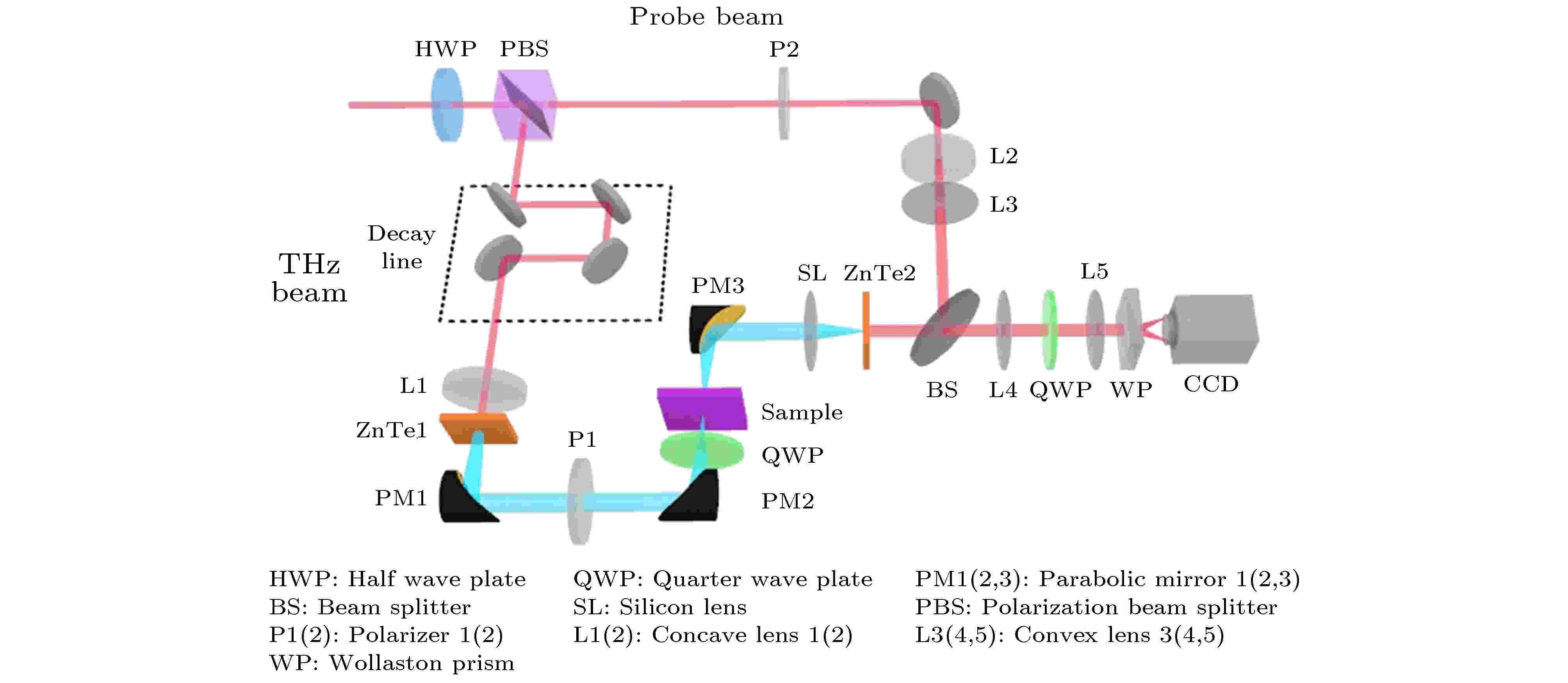
2020, 69 (20): 208702.
doi: 10.7498/aps.69.20200766
Abstract +
Fabricating integratable and high-efficiency optical polarization devices is one of the fundamentally important challenges in the field of terahertz optics. Compared with the traditional polarization materials such as quartz crystal and liquid crystal, MgO crystal is one of the most important potential candidates for fabricating terahertz optical devices due to its high transmittance in terahertz frequency region. To determine the birefringence characteristics of MgO crystal in the terahertz frequency region, the modulation of the polartization state of a terahtertz wave through a $\left\langle {100} \right\rangle $ crystalline MgO flake is studied using terahertz focal plane imaging method. Within this approach, the polarization of a terahertz wave can be intuitively identified from the imaging of the amplitude and the phase of the z-direction component of terahertz electronic field. By measuring the imaging of both the amplitude and the phase of terahertz field with and without passing through the $\left\langle {100} \right\rangle $ crystalline MgO flake, it is found that the left and right circularly polarized light are converted into perpendicular linearly-polarized light after passing through the MgO flake. The polarization direction of the linearly polarized light changes with the rotating of MgO flake along the direction perpendicular to the light propagation. The conversion between the linearly polarized light and the circularly polarized light is analyzed by using the Jones matrix approach. These properties indicate that the $\left\langle {100} \right\rangle $ crystalline MgO flake acts as a quarter wave plate for terahertz waves. To further identify the character of terahertz quarter wave plate, the refractive index of the ordinary and extrordinary light within terahertz frequency region of crystalline MgO crystal are measured by using transmission terahertz time-domain spectroscopy system. By comparing the phase difference between the ordinary and extraordinary light after passing through the MgO flake, it is shown that a quarter of wavelength difference between the ordinary and extraordinary light is obtained. These results indicate that the $\left\langle {100} \right\rangle $ crystalline MgO crystals can be used to fabricate quarter wave plates and relevant polarization devices in the terahertz band.

2020, 69 (20): 208703.
doi: 10.7498/aps.69.20200662
Abstract +
The THz wave has good photonic and electronic properties, and has high penetration for non-polar materials, but its own photon energy is low. In addition, the THz wave also has characteristics such as wide bandwidth and large communication capacity, thereby making the THz wave possess important academic value and wide application prospects in the fields of non-destructive testing, biomedical imaging and communication. The development of THz technology requires not only high-performance THz waveguide technology for efficient transmission of THz waves, but also important optical devices such as optical switches, modulators, and couplers that are suitable for THz bands. With the in-depth study of THz waveguide technology, researchers have proposed many high-performance THz waveguide structures, such as metal hollow core tube waveguide, parallel metal plate waveguide, photonic crystal fiber and microstructure hollow core fibers, among which hollow-core photonic crystal fibers and hollow-core anti-resonant fibers (HC-ARF) have developed rapidly in recent years. So far, THz single-mode single-polarization fiber and high-birefringence fiber have been widely studied, but the researches on the fiber structure and devices that realize THz wave directional coupling are relatively rare. In this paper, we study the influences of the arrangement and distribution of the inner and outer claddings of HC-ARF on transmission characteristics, and thus design a new type of THz dual-core anti-resonant fiber. Compared with ordinary quartz fiber couplers and dual-core photonic crystal fibers, it can utilize a relatively simple structure and achieve directional coupling above 2 THz. Using the finite element analysis method to theoretically analyze the loss characteristics and coupling characteristics of the fiber, it is found that HC-ARF changes the periodic arrangement and distribution of the inner cladding tube within a certain range, which can achieve mode leakage without affecting the fiber transmission characteristics. So the THz dual-core anti-resonant fiber can be designed by using the mode leakage coupling mechanism. By changing the core distance and core gap size, the directional coupling with a coupling length of 0.72 m is realized at a transmission frequency of 2.5 THz. This terahertz dual-core anti-resonance fiber will have an important application value in terahertz optical devices such as terahertz optical switches, modulators and couplers.
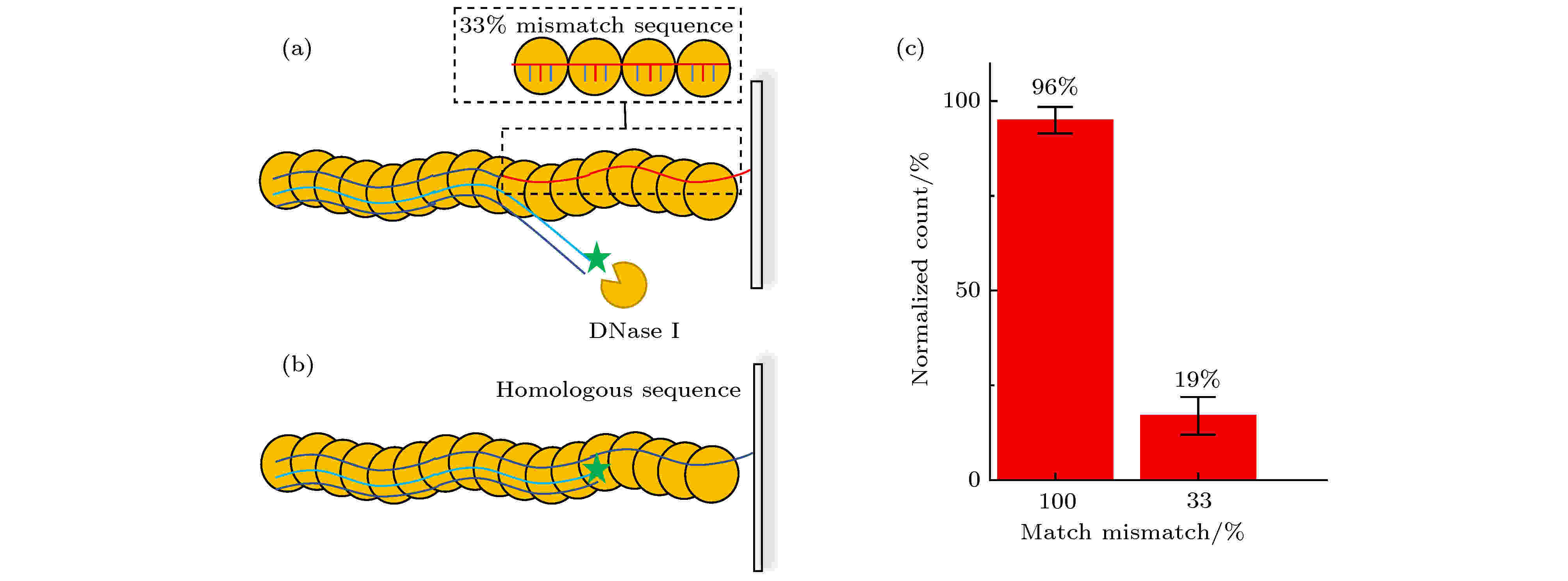
2020, 69 (20): 208706.
doi: 10.7498/aps.69.20200959
Abstract +
Homologous recombination (HR) which is important for maintaining the genetic stability of the cell is mainly mediated by recombinase. As a critical recombinase exists in prokaryotic organism, RecA has been widely studied. RecA could bind single strand DNA to form a filament structure to perform strand invasion and exchange with homologous DNA. The basic strand exchange step is a pathway to investigating the mechanism of strand exchange process. However, the specific step length is still controversial. The mainstream view is to regard the basic step as 3 bp, which sounds reasonable because the basic unit of RecA filament is a RecA monomer which binds 3 base pairs, but our previous study found that the most probable basic strand exchange step is 9 bp. In this research, we set up a series of experiments to demonstrate that the basic strand exchange step is 9 bp and how the mismatch base pairs in 9 bp affect the strand exchange process. We ues digestion protection to confirm whether the strand exchange process is completed and we employ a magnetic tweezer to measure how many base pairs are exchanged by strand exchange process. The digestion protection experiments show the strand exchange cannot overcome 33% mismatch sequence, but according to the result that strand exchange could overcome a single mismatch base pair, so that the step is not 3 bp. According to strand exchange length of 33% mismatch sequence, we find a 9 bp interval between the main peaks, which implies that the strand exchange step should be 9 bp rather than 3 bp. We also use continuous mismatch base pairs instead of periodic mismatch sequence to see whether the strand exchange process can be overcome. We find that the more the mismatch base pairs, the harder the strand exchange process passes across. Homology degree and its distribution both affect the strand exchange process. In general, the results suggest that the strand exchange step mediated by RecA is 9 bp, and the number of mismatched base pairs and their distribution influence the strand exchange process. The combination of digestion protection assay and magnetic tweezers can further take advantage of single molecule techniques to investigate mechanism of HR.








